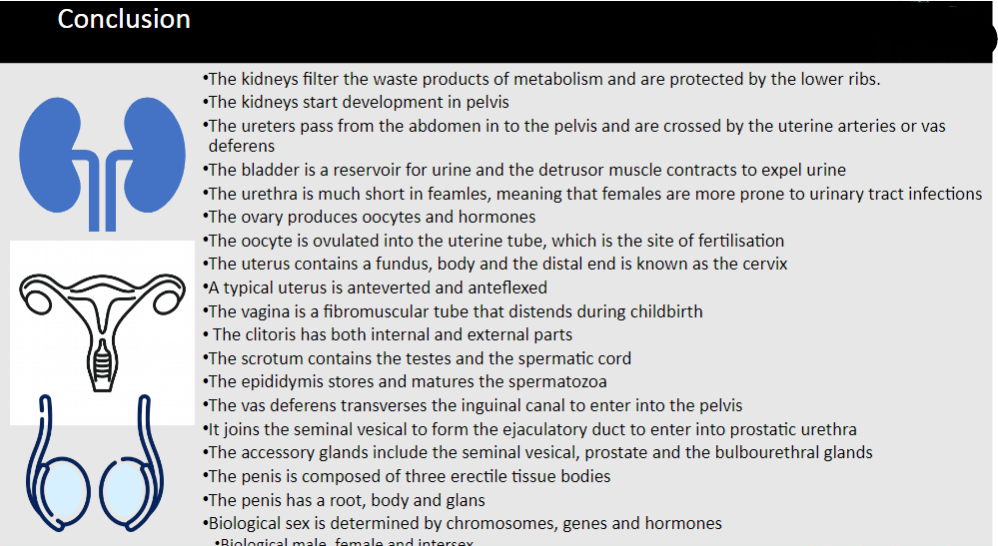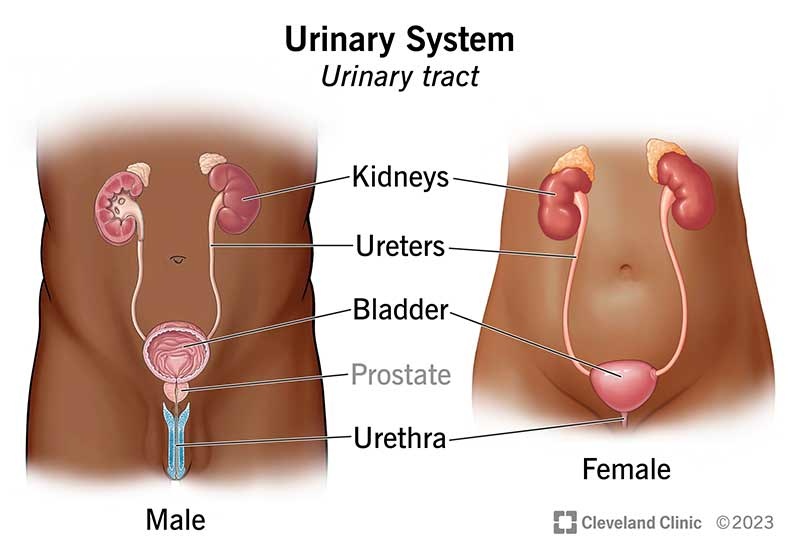
Genitourinary System (Anatomy)
This session will introduce you to the anatomy of the genitourinary system. A pre-recorded lecture is provided for you to introduce the learning objectives and direct you through these. You will need to explore the additional recommended resources to assist in your learning. The urinary and genital (or reproductive) systems may be considered together since they are closely linked. The similarities and differences of the male and female genitourinary systems will be explored and emphasis will be placed on the functional anatomy of the different structures therein.
-
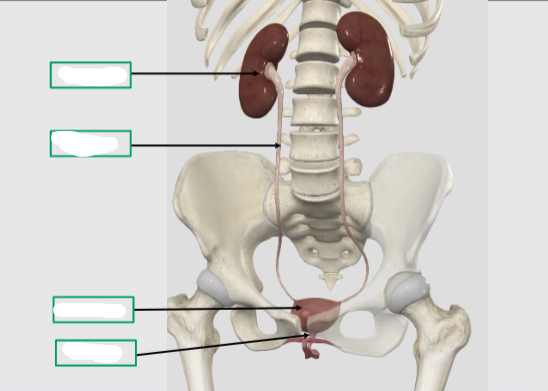
Name these parts of the Urinary system:
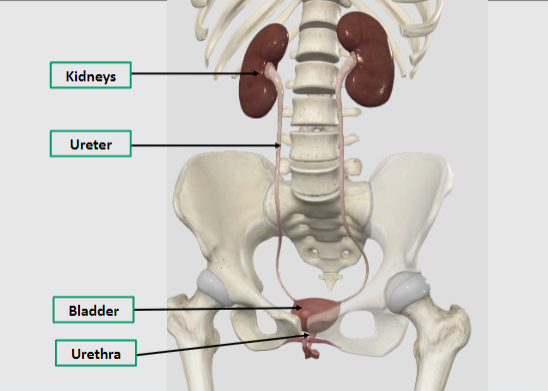
-
What are the functions of the kidneys? (7)
Excretion of waste products of metabolism
Regulation of water and electrolyte balance in the body
Maintenance of acid-base balance in the body
Secretion of hormones such as erythropoietin and renin into the bloodstream
Filtration of approximately 113 to 144 pints of blood per hour
Complete filtration of the entire blood volume approximately 400 times a day
High blood flow rate, even surpassing that of the heart
-
What are primary retroperitoneal organs?
Organs located behind the peritoneum, including the kidneys.
-
Why is the left kidney situated higher than the right?
Due to the space occupied by the liver on the right side of the body.
-
What are the approximate locations of the superior poles of the left and right kidneys?
The superior pole of the left kidney is between the 11th and 12th ribs, while the superior pole of the right kidney is near the 12th rib.
-
Between which vertebrae are the kidneys located?
The kidneys are positioned between the T12 and L3 vertebrae.
-
How do the kidneys move during respiration?
As the diaphragm contracts during respiration, the kidneys move downwards.
-
Can the lower pole of the kidneys usually be palpated?
Yes, the lower pole of the kidneys can usually be palpated.
-
Where do kidneys originally develop?
Kidneys originally develop in the pelvis.
-
What happens to the kidneys during development?
They ascend into the abdomen.
-
What is the consequence of maldevelopment in kidney positioning?
Maldevelopment can result in ectopic kidneys, which are congenitally misplaced but often have normal structure and function.
-
What is a risk associated with malposition of ureters?
Malposition of ureters predisposes them to obstruction, leading to a condition called hydronephrosis.
-
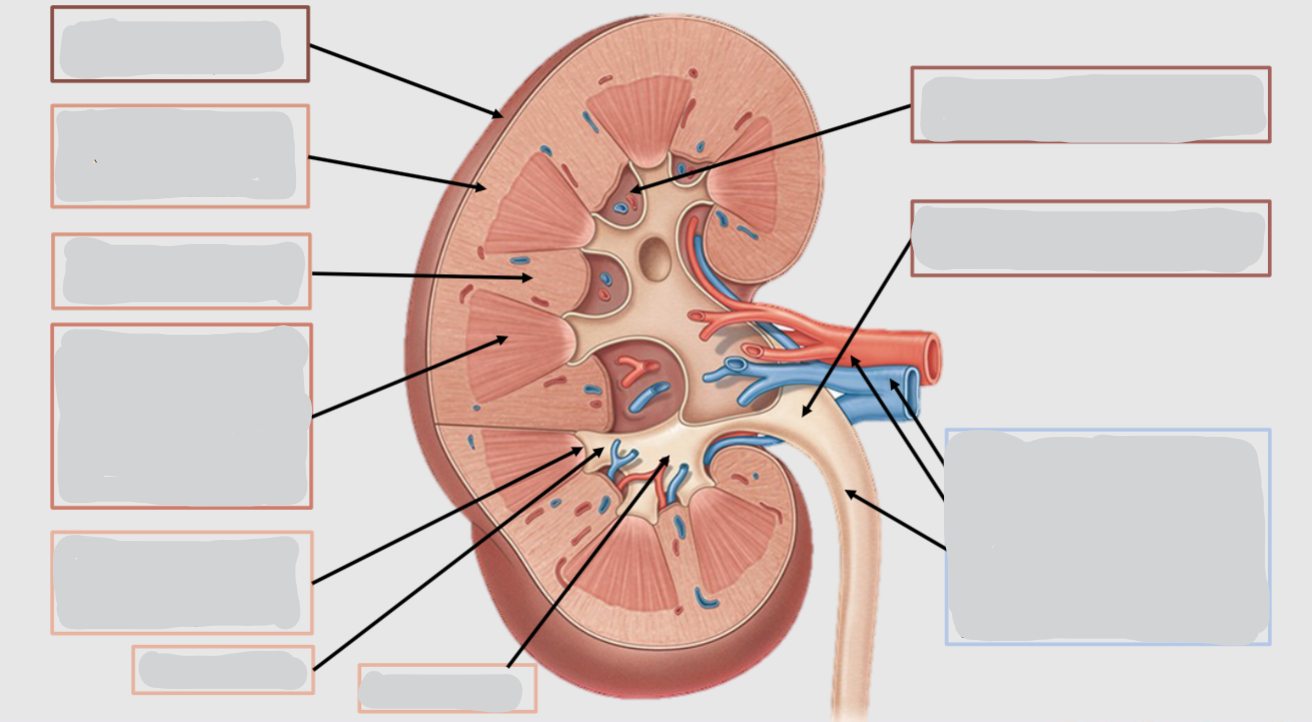
Label the Internal anatomy of the kidney
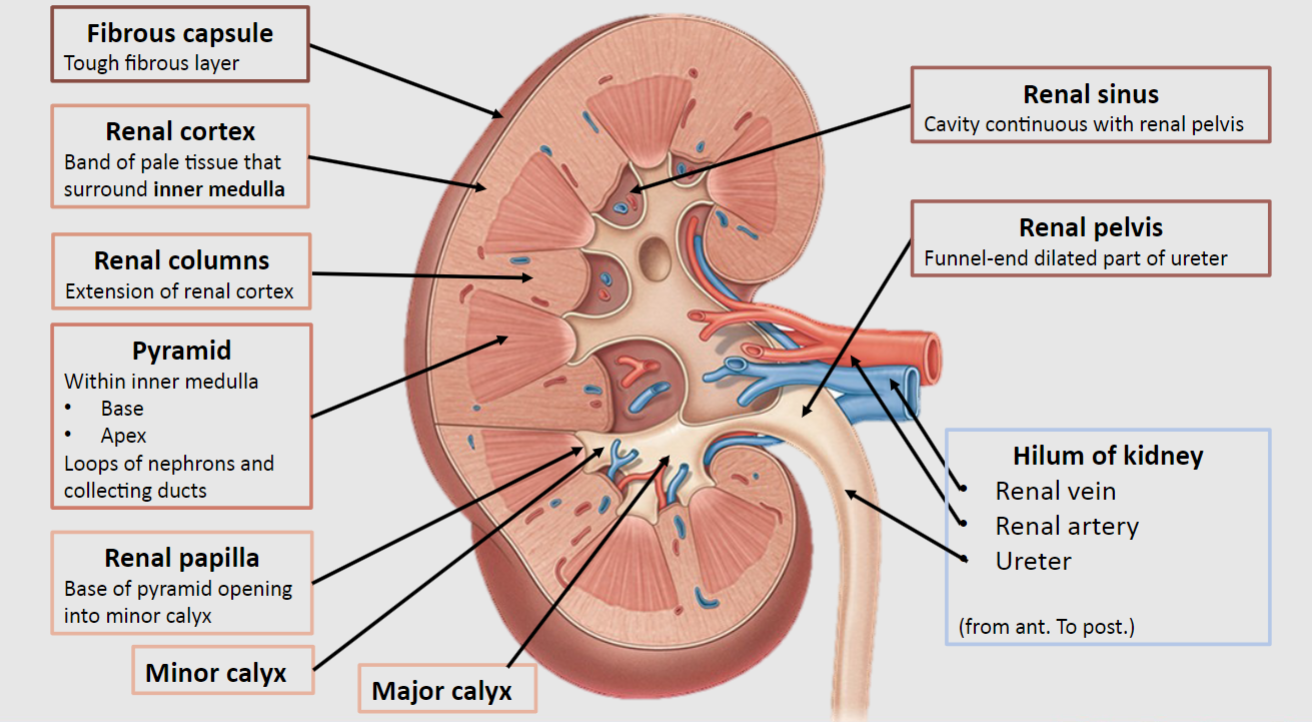
-
What is the structure of the ureter?
The ureter is a long muscular tube, typically measuring 25 to 30 cm in length.
-
What is the function of the ureter?
The ureter transports urine from the kidney to the urinary bladder through peristaltic contractions.
-
Where does the ureter begin and end?
It begins as a continuation of the renal pelvis and extends to the urinary bladder.
-
What is the course of the ureter in relation to the muscles of the posterior abdominal wall?
The ureter descends anterior to the muscles of the posterior abdominal wall, including the psoas major muscle.
-
Where does the ureter cross during its course into the pelvis?
The ureter crosses the bifurcation of the common iliac artery to enter the pelvis.
-
What structures cross the ureter near its termination?
Near its termination, the ureter is crossed by the vas deferens in males and the uterine artery in females.
-
How does the ureter pass through the bladder wall?
The ureter passes obliquely through the wall of the bladder.
-
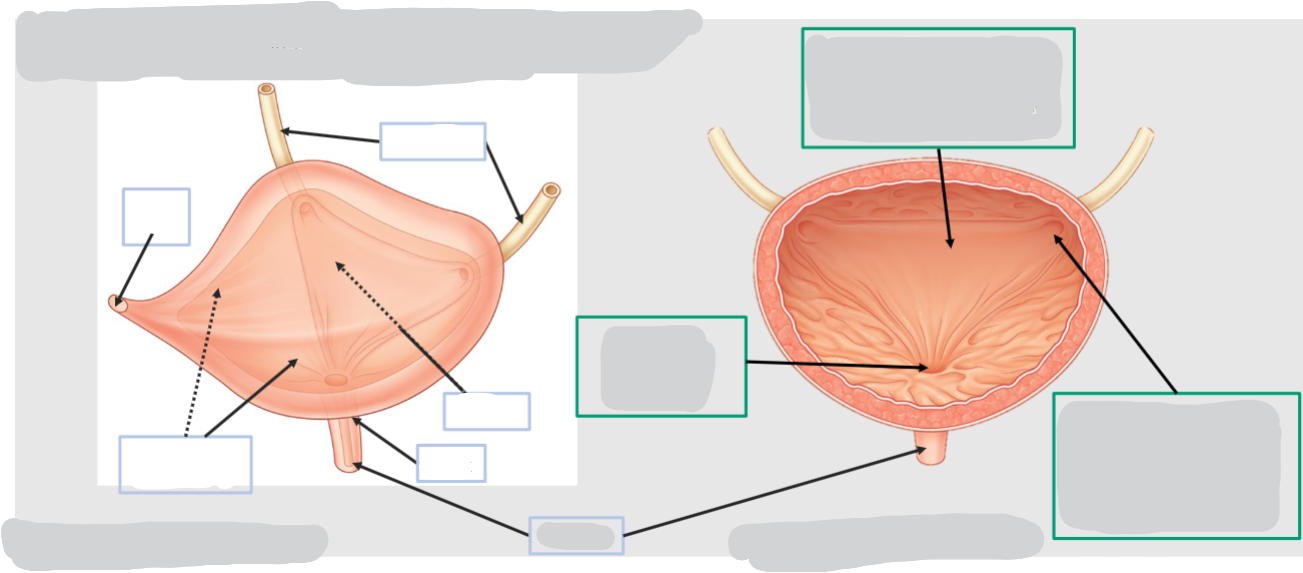
Label these parts of the bladder:
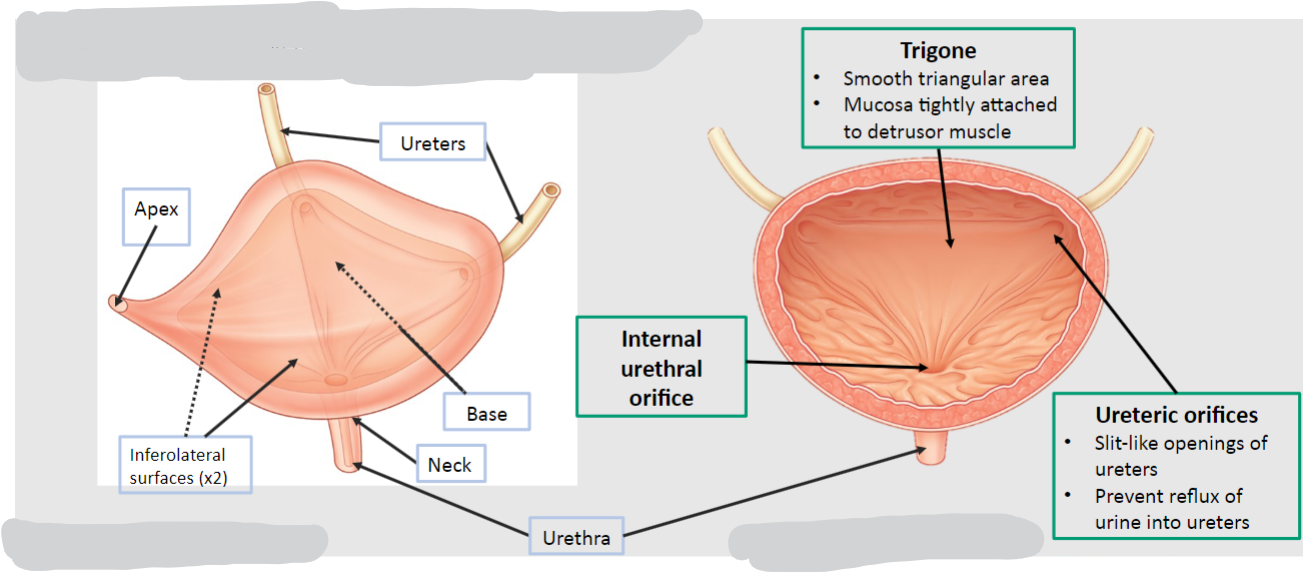
-
What is the function of the urethra in biological females?
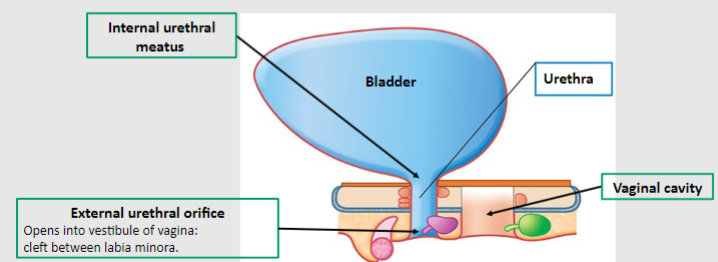
The urethra transports urine.
-
What are the dimensions of the female urethra?
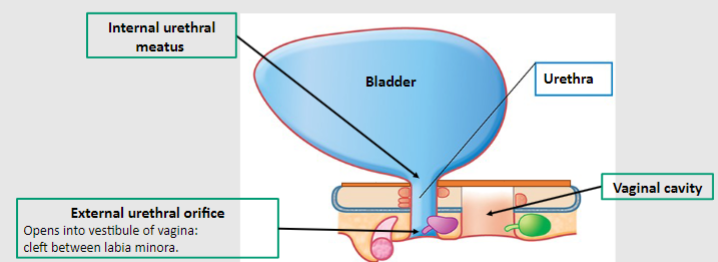
The female urethra is approximately 4 cm in length and has a diameter of about 6 mm.
-
What is the anatomical extent of the female urethra?
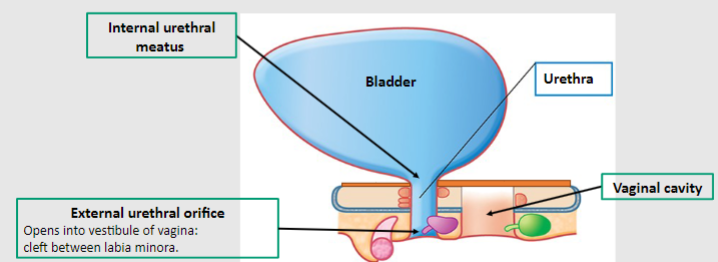
The female urethra extends from the internal urethral meatus to the external urethral meatus.
-
In relation to the vaginal cavity, where is the female urethra located?
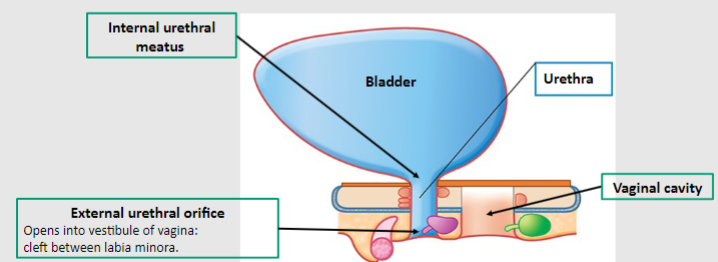
The female urethra is anterior to the vaginal cavity.
-
How does the length of the male urethra compare to that of females?
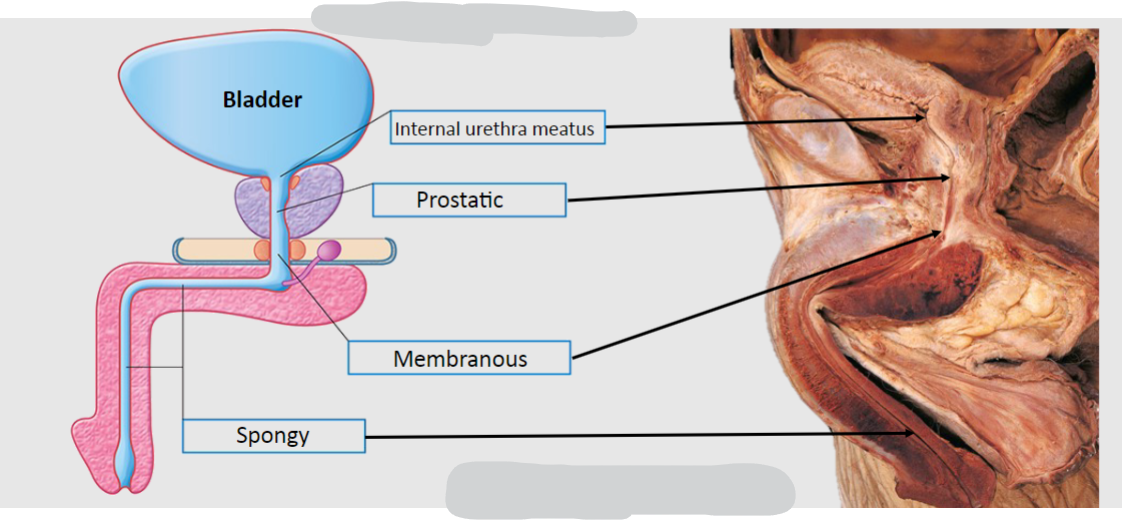
The male urethra is much longer than the female urethra, approximately 20 cm in length.
-
What are the functions of the male urethra?
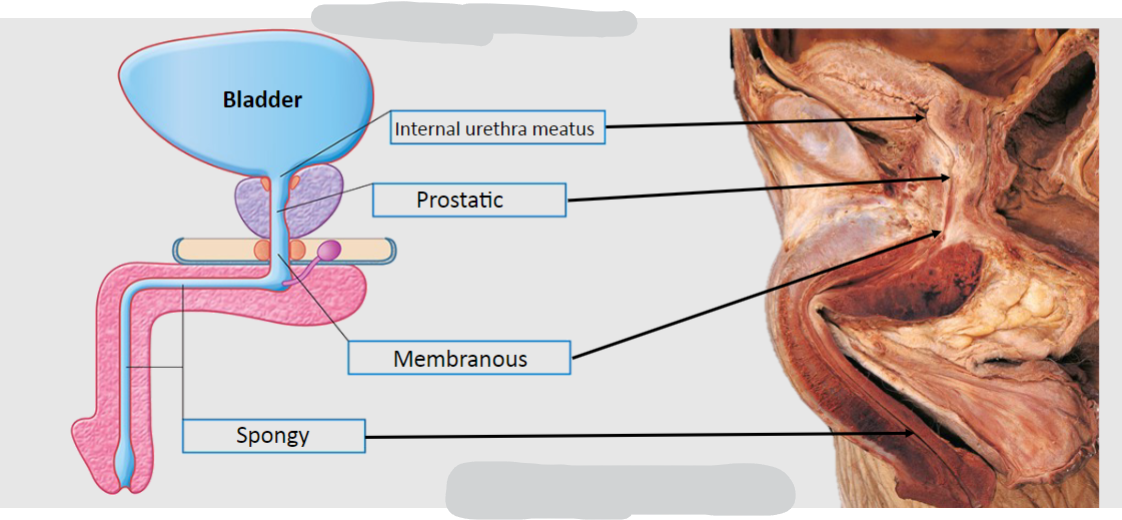
The male urethra expels urine and semen via the external urethral meatus.
-
How many parts is the male urethra divided into?
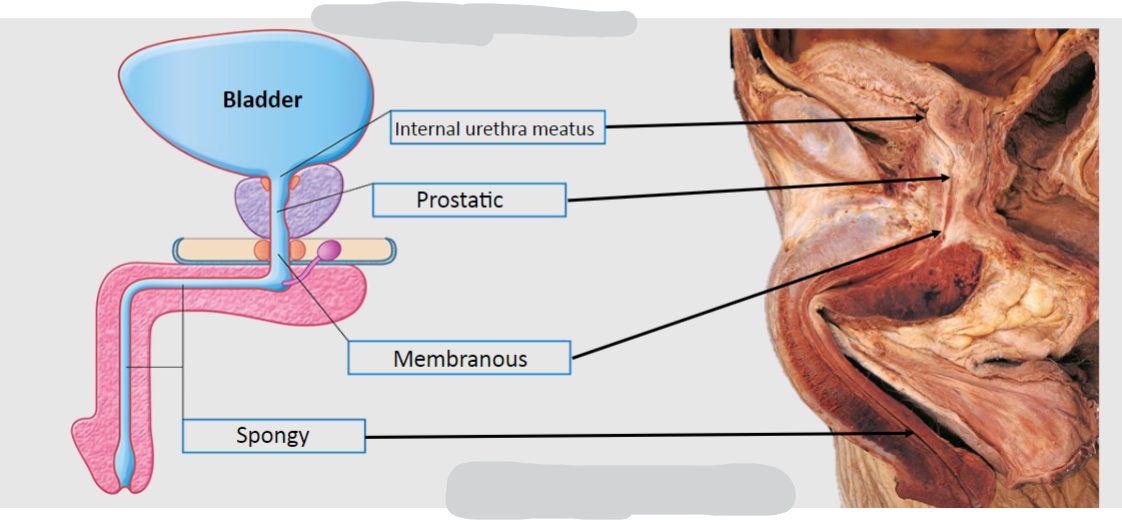
The male urethra is divided into three parts: prostatic, membranous, and spongy urethra.
-
How many bends does the male urethra have in a flaccid penis?
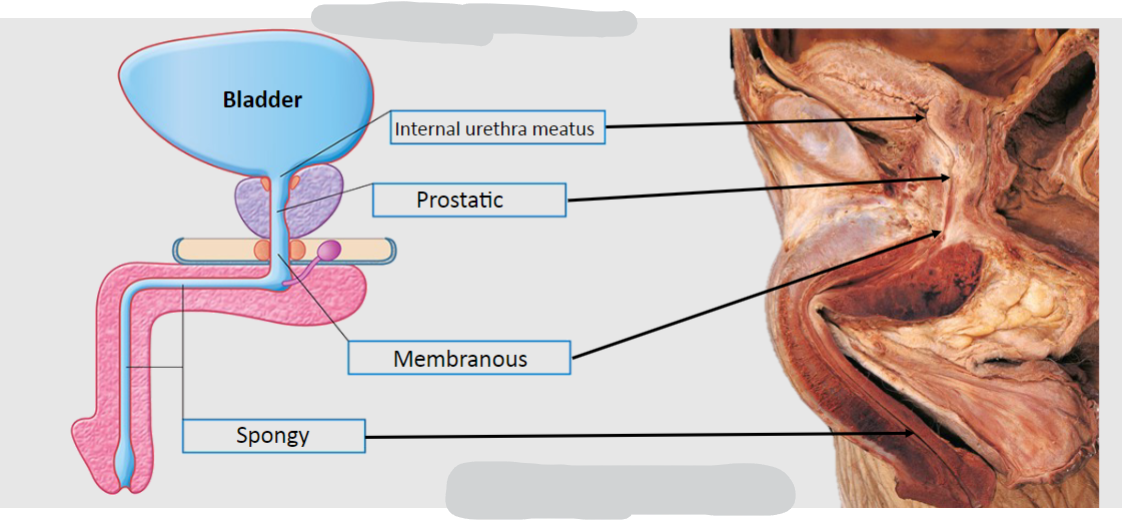
The male urethra bends twice in a flaccid penis.
-
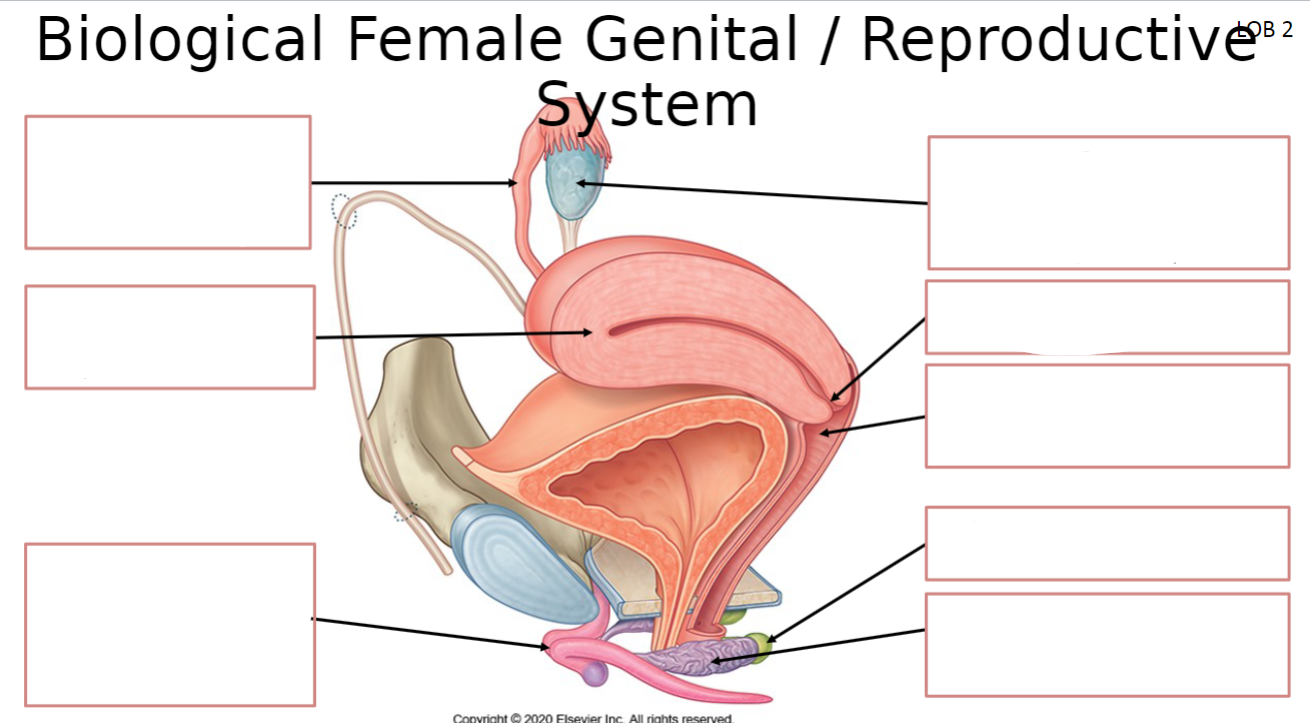
State these parts of the female genital reproductive system: If you can also elaborate on each part
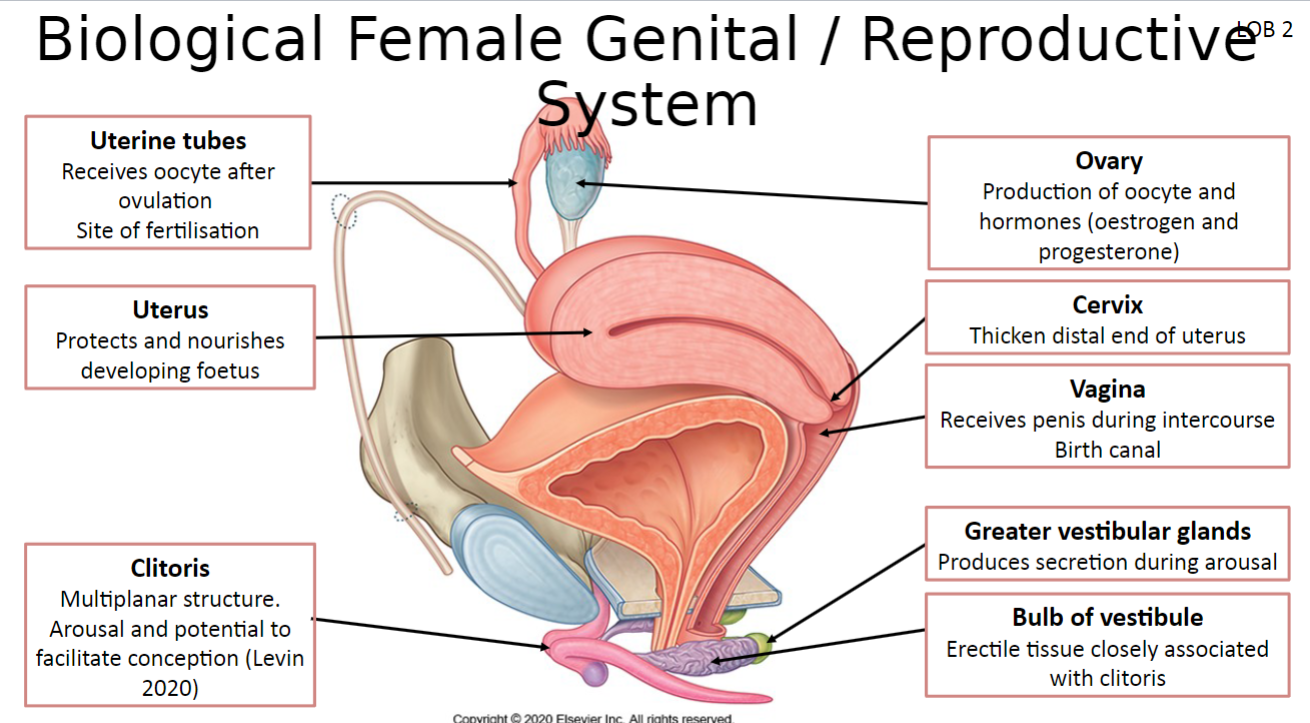
-
What are the functions of the ovaries?
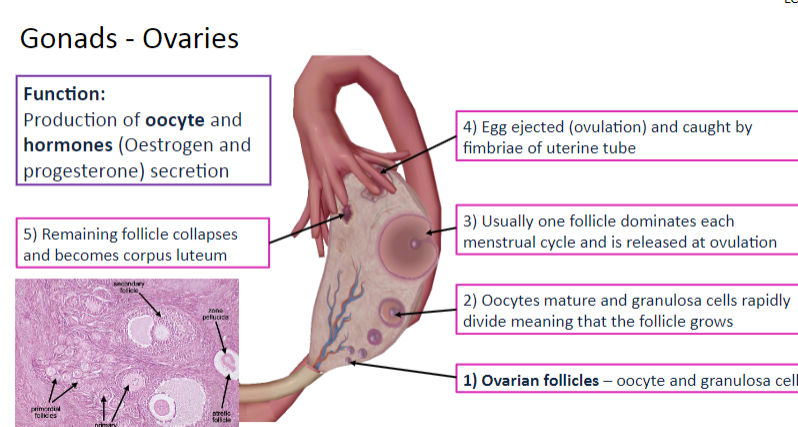
The ovaries are responsible for the production of oocytes (eggs) and the secretion of hormones, including estrogen and progesterone.
-
What are ovarian follicles composed of?
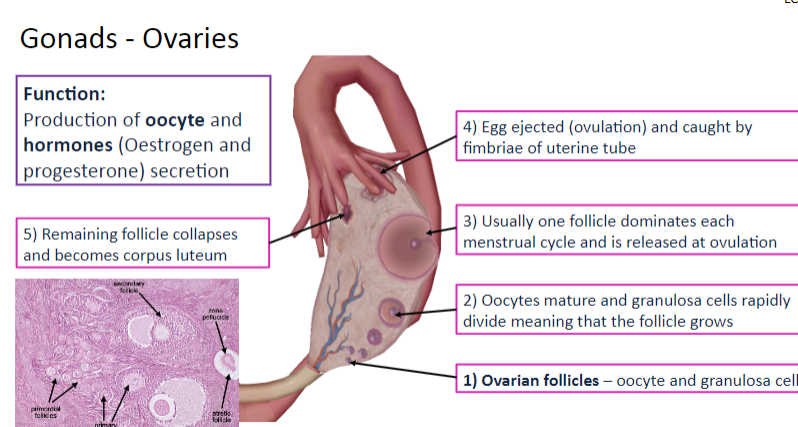
Ovarian follicles consist of an oocyte surrounded by granulosa cells.
-
What happens to oocytes and granulosa cells during follicle development?
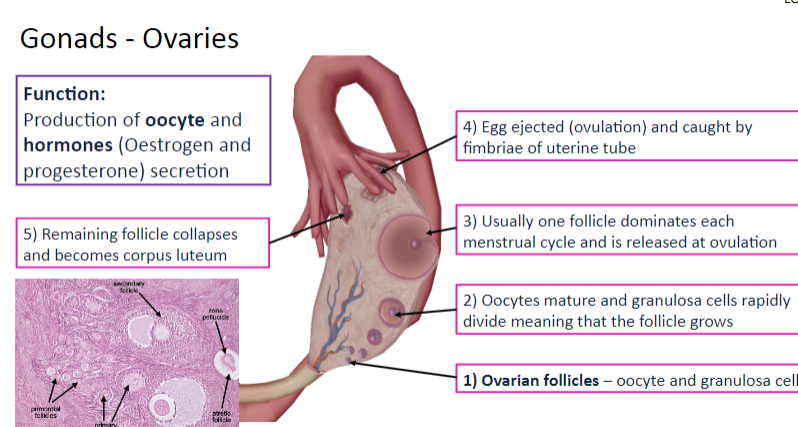
Oocytes mature and granulosa cells rapidly divide, leading to the growth of the follicle.
-
What typically happens during each menstrual cycle regarding follicle dominance?
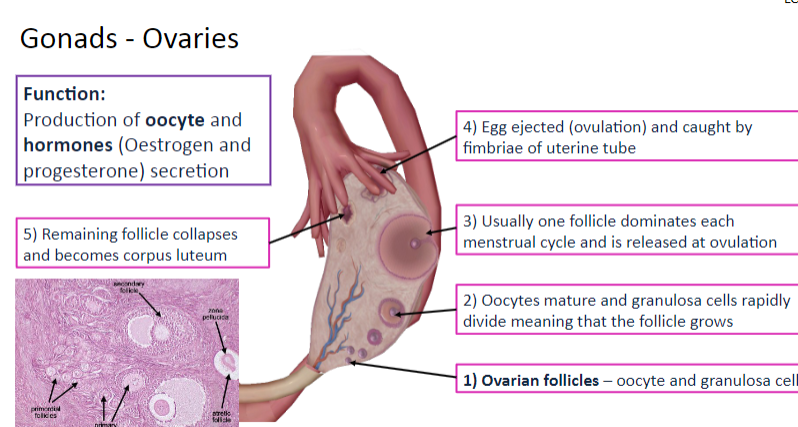
Usually, one follicle dominates each menstrual cycle and is released at ovulation.
-
What occurs during ovulation?
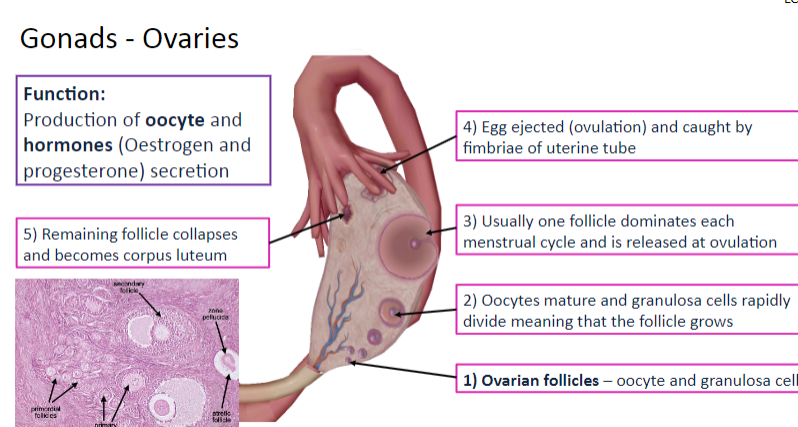
The egg is ejected (ovulation) and caught by the fimbriae of the uterine tube.
-
What happens to the remaining follicle after ovulation?
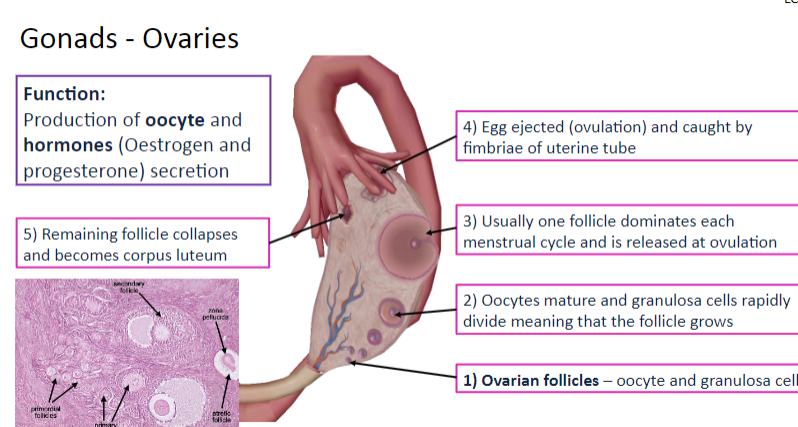
The remaining follicle collapses and becomes the corpus luteum.
-
What are fimbriae?
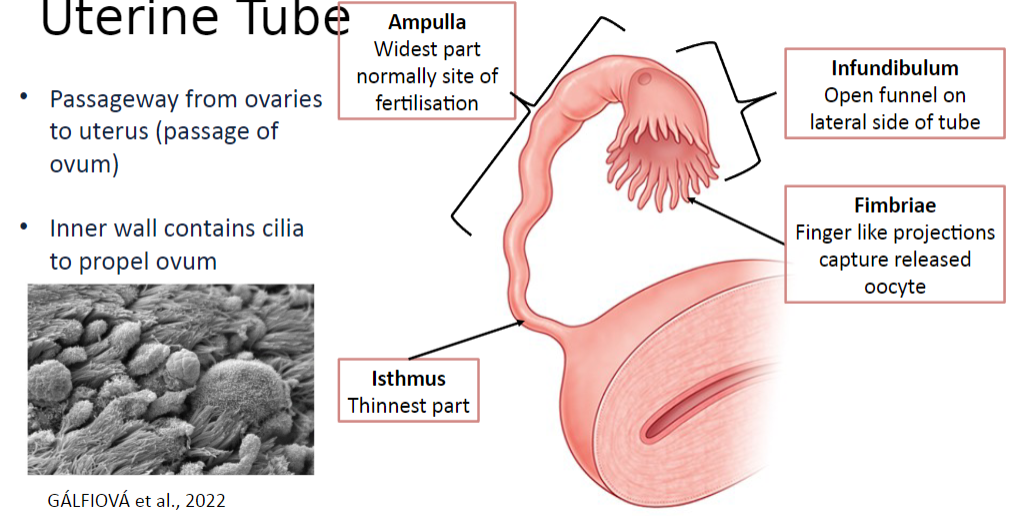
Fimbriae are finger-like projections that capture the released oocyte.
-
What is the infundibulum?
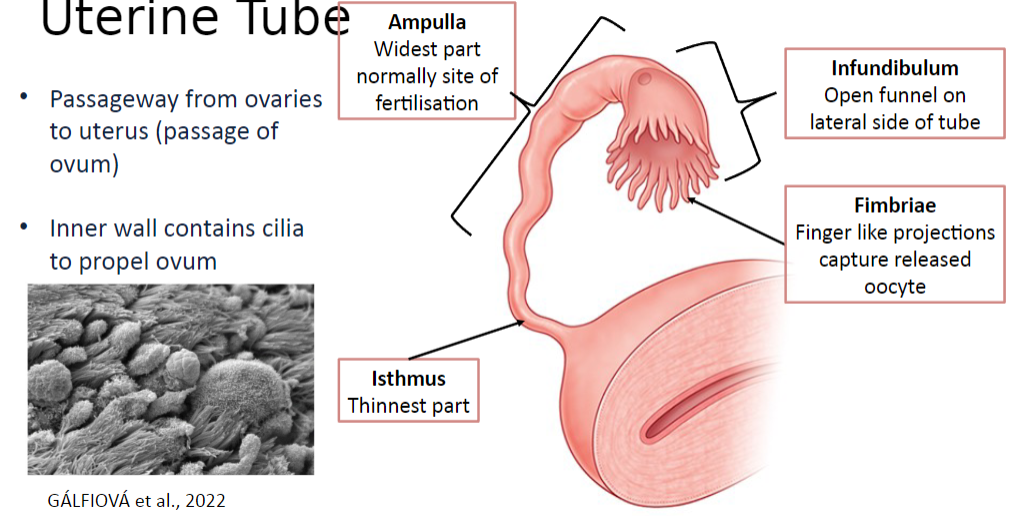
The infundibulum is an open funnel on the lateral side of the tube.
-
What is the ampulla?
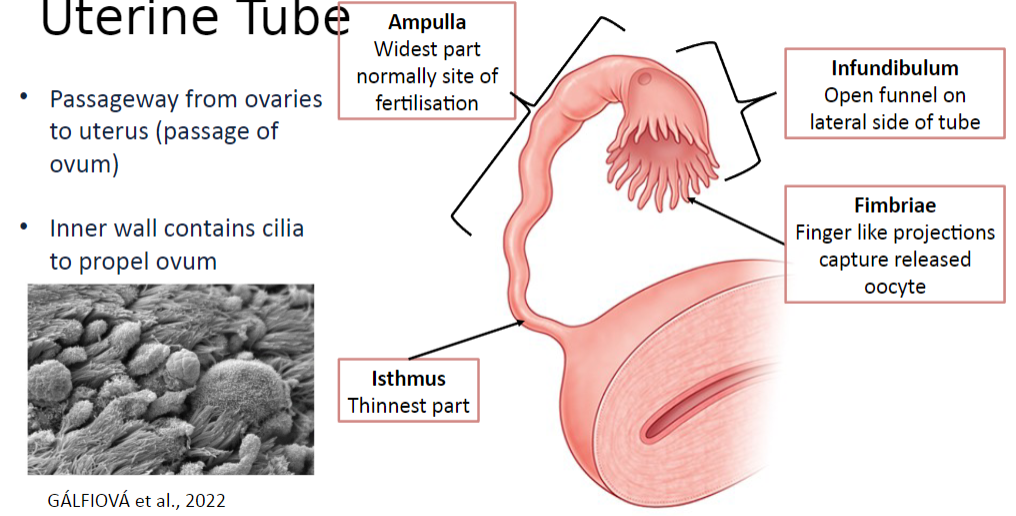
The ampulla is the widest part of the uterine tube and is normally the site of fertilization.
-
What is the isthmus?
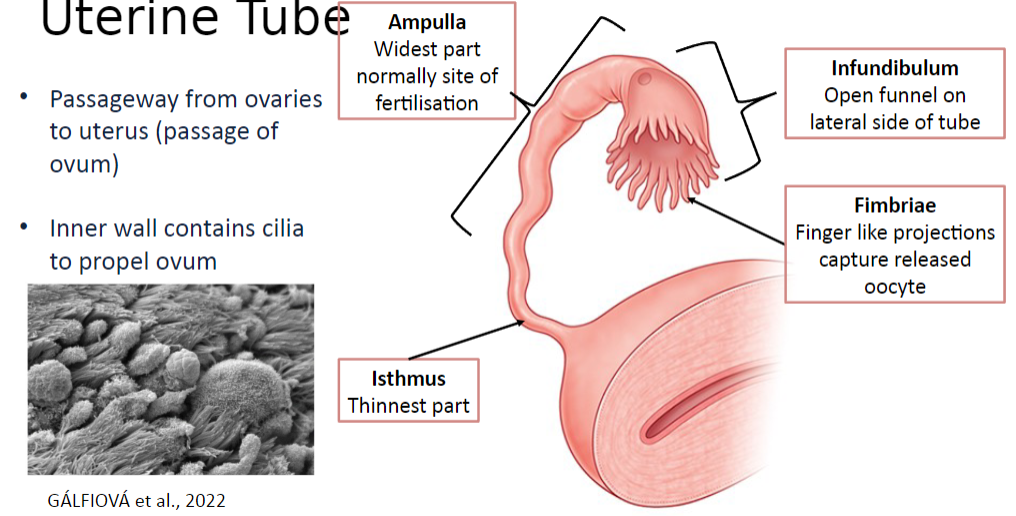
The isthmus is the thinnest part of the uterine tube, serving as a passageway from the ovaries to the uterus for the passage of the ovum.
-
What is the function of the cilia in the inner wall of the uterine tube?
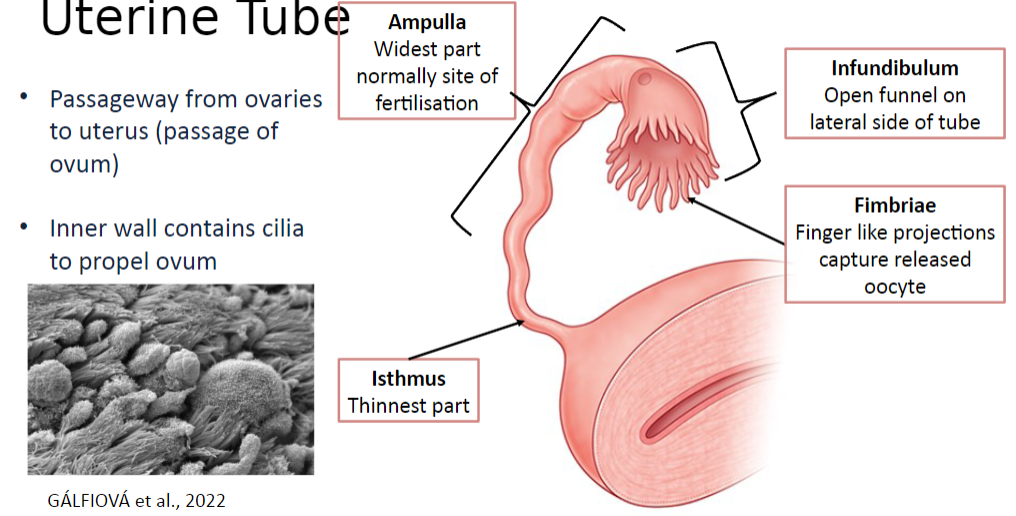
The cilia in the inner wall of the uterine tube propel the ovum along the tube.
-
What is the structure of the uterus?
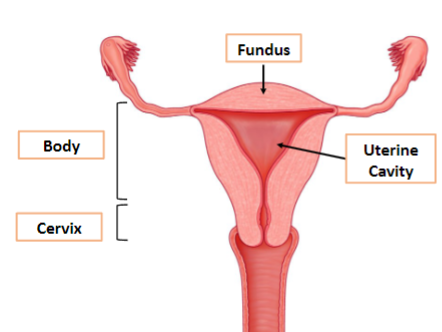
The uterus is a hollow, pear-shaped muscular (smooth muscle) organ that protects and nourishes a developing fetus.
-
What are the three layers of the uterine wall?
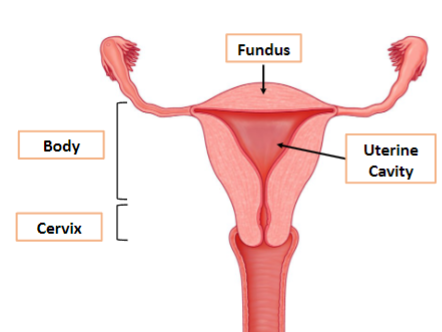
The three layers of the uterine wall are:
Perimetrium: the outer serous wall covering the uterus.
Myometrium: the thick muscular layer responsible for the process of parturition (childbirth).
Endometrium: the inner mucous layer, which serves as the site of implantation and undergoes thickness changes throughout the menstrual cycle.
-
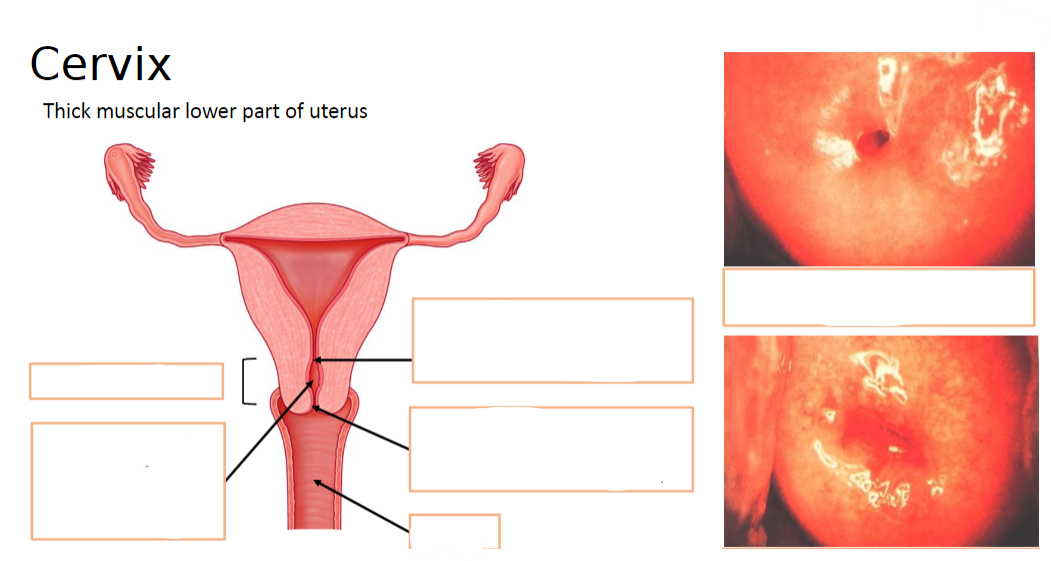
Label these parts of the cervix:
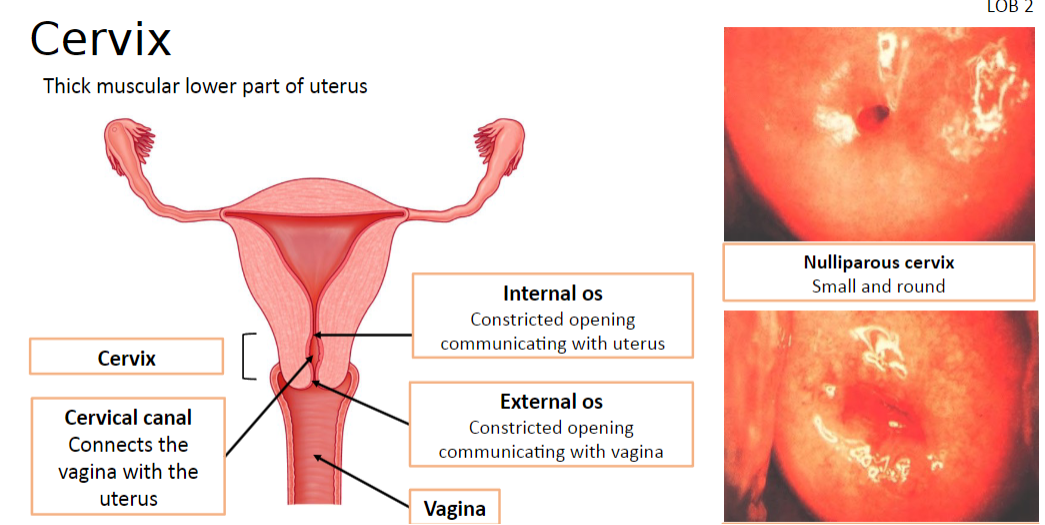
-
What is the cervix?
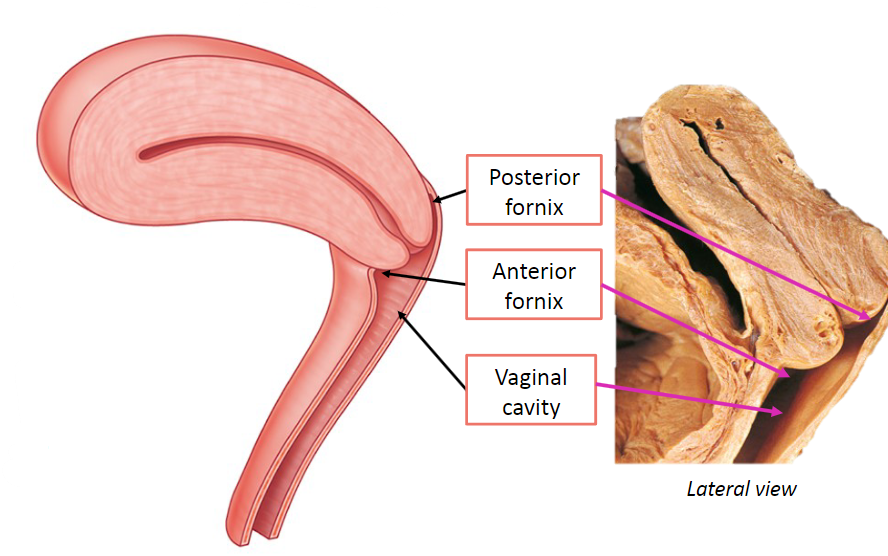
The cervix is the thick muscular lower part of the uterus.
-
What are the functions of the vagina?
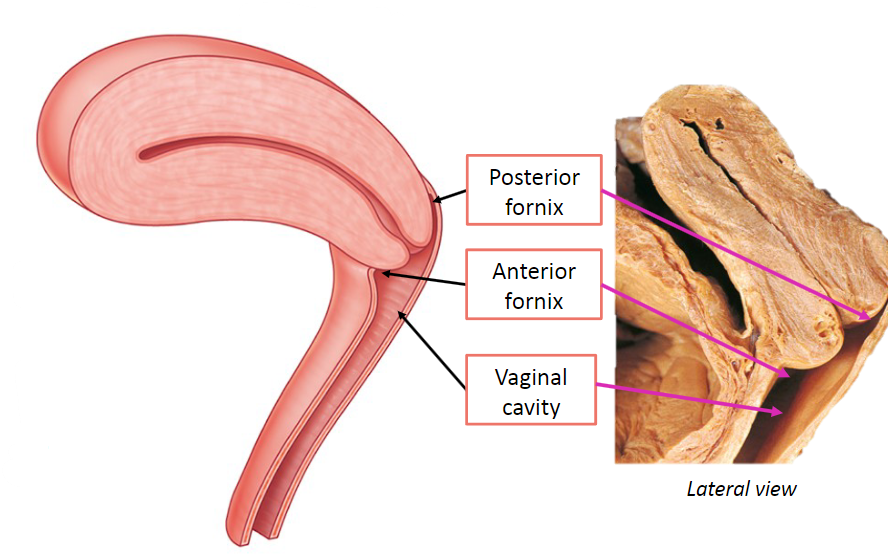
The vagina serves as a canal for menstruation, receives the penis during copulation (for semen deposition), and acts as the birth canal during childbirth.
-
How would you describe the structure of the vagina?
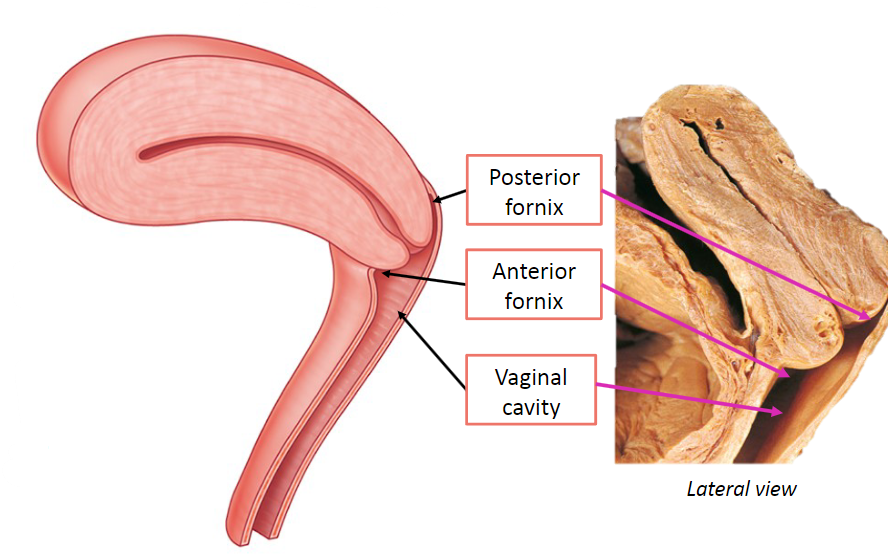
The vagina is a distensible fibromuscular tube.
-
How is the area of the vaginal lumen divided?
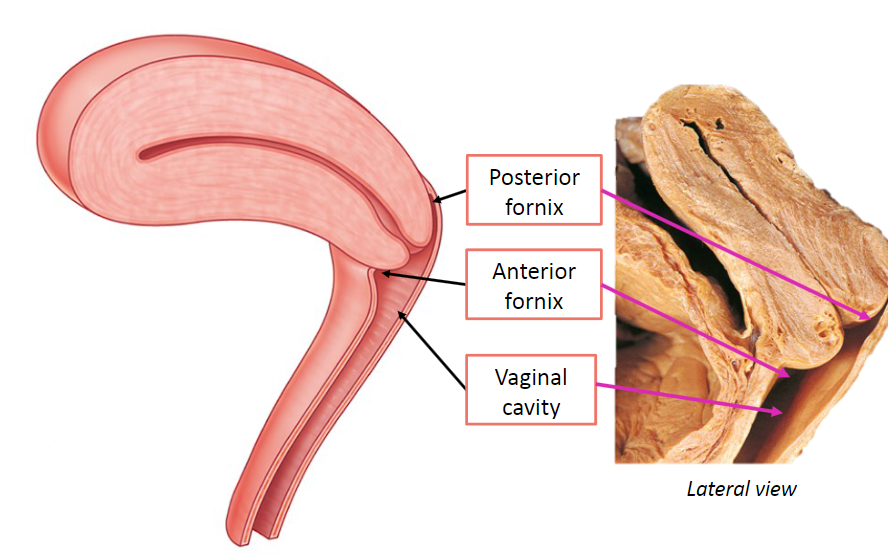
The area of the vaginal lumen, particularly surrounding the cervix, is divided into four parts: anterior, posterior, and left and right lateral fornices.
-
What is anteflexion of the uterus?
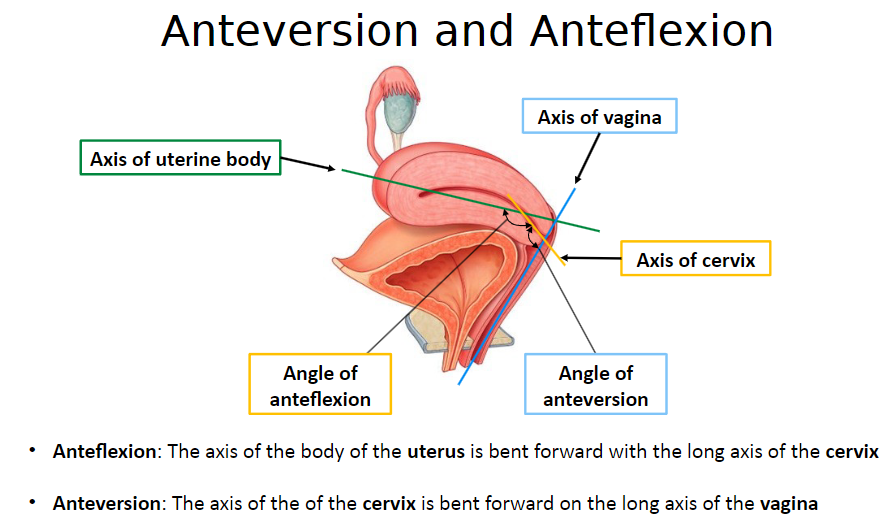
Anteflexion is when the axis of the body of the uterus is bent forward with the long axis of the cervix.
-
What is anteversion of the cervix?
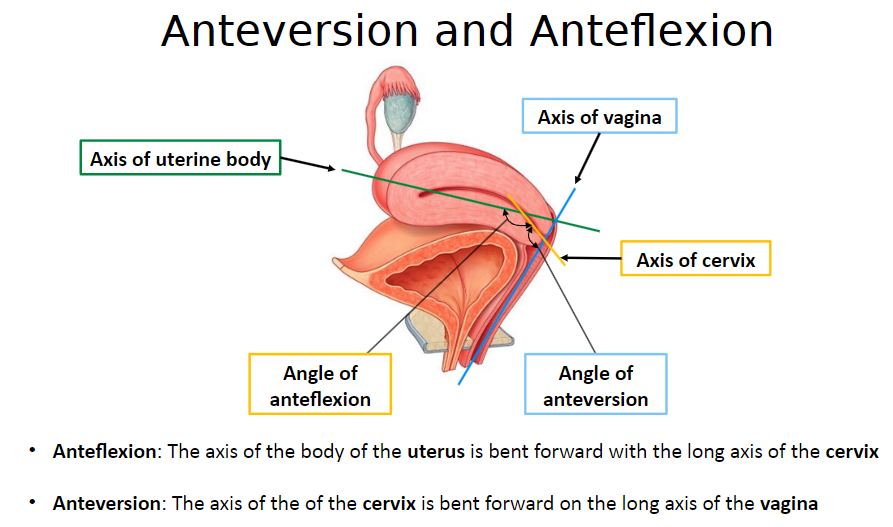
Anteversion is when the axis of the cervix is bent forward on the long axis of the vagina.
-
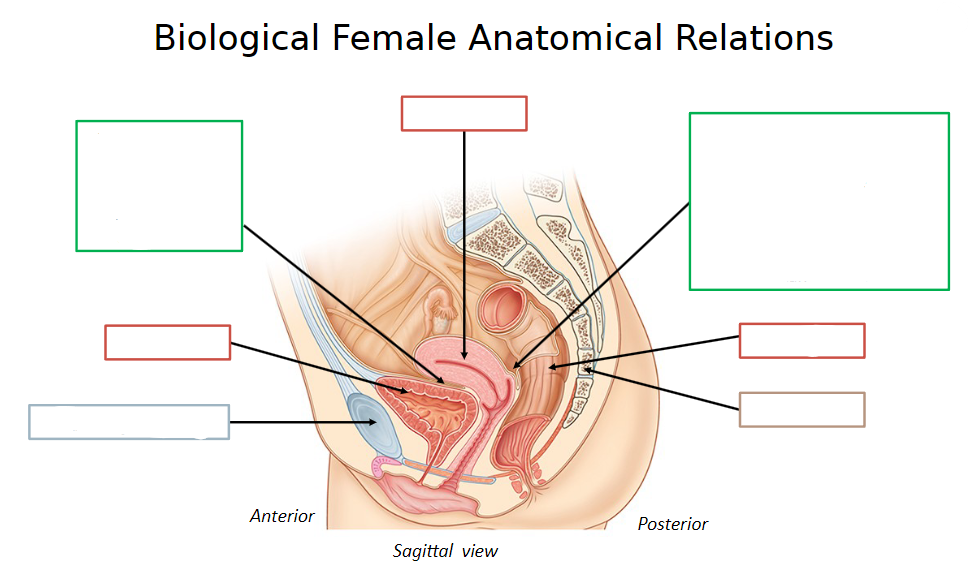
Can you state these parts of female anatomy?
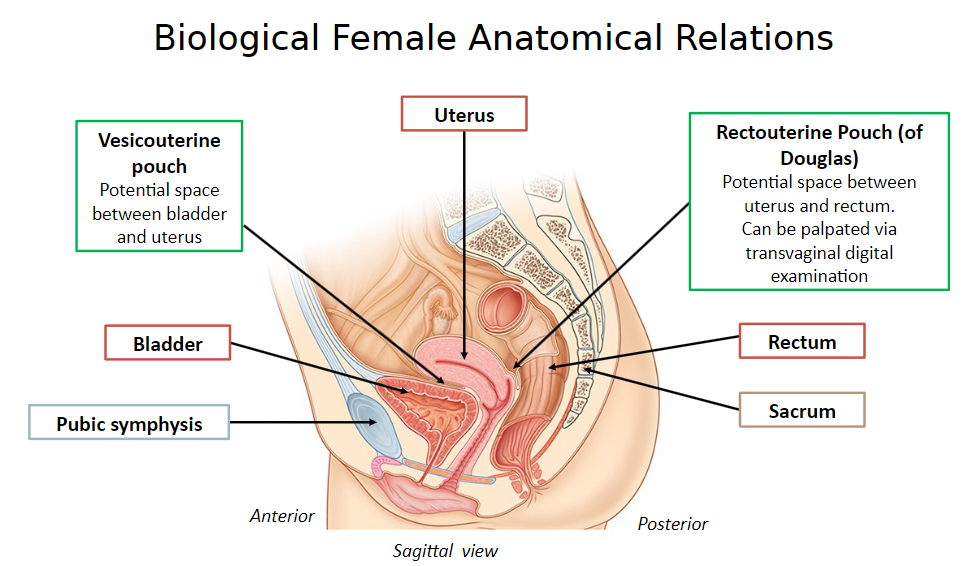
-
What is the structure of the clitoris?
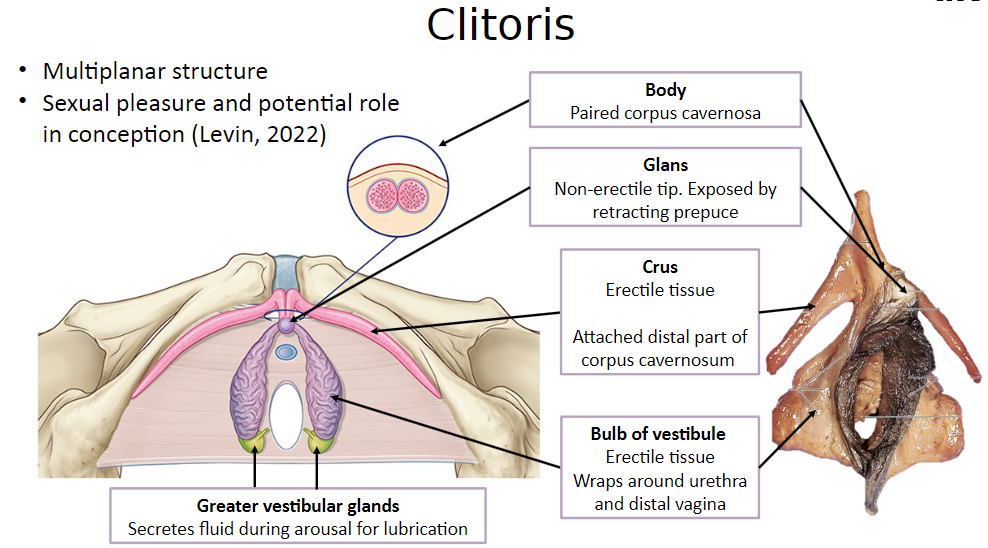
The clitoris is a multiplanar structure.
-
What are the functions of the clitoris?
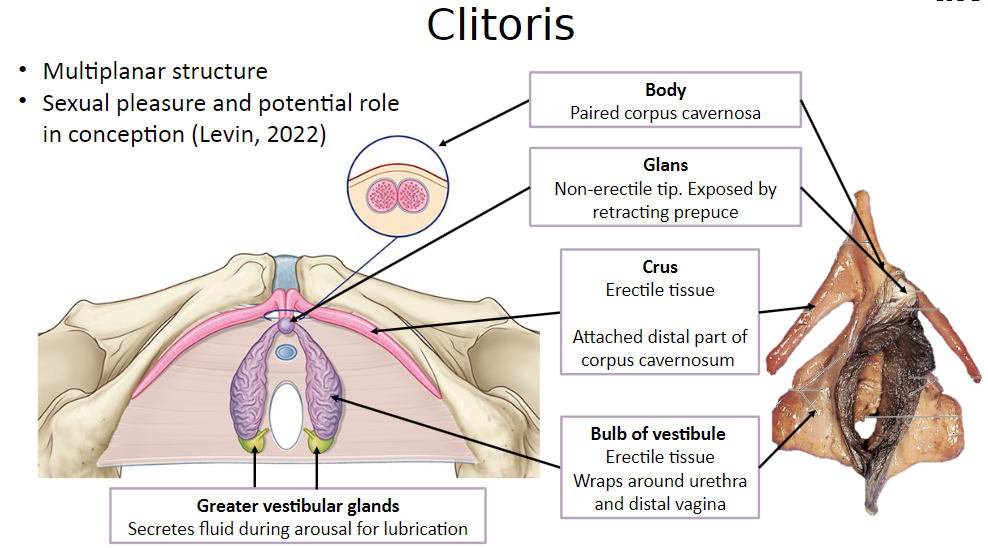
The clitoris is involved in sexual pleasure and may have a potential role in conception.
-
Picture demonstrating the picture of external female genitalia:
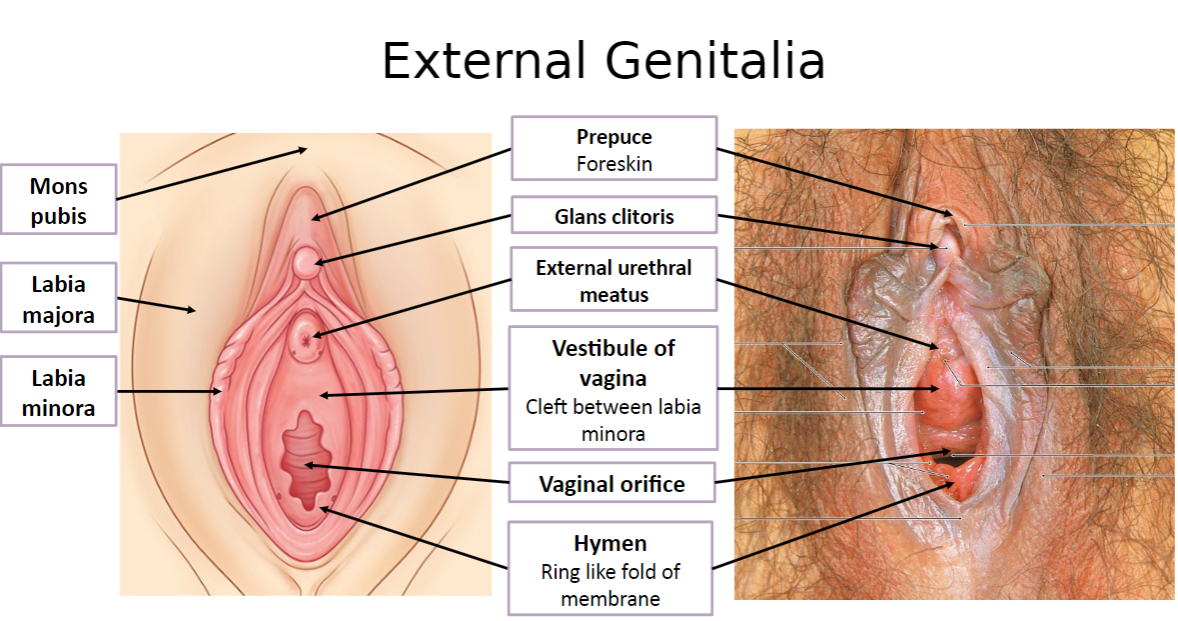
-
Picture demonstrating the male reproductive system:
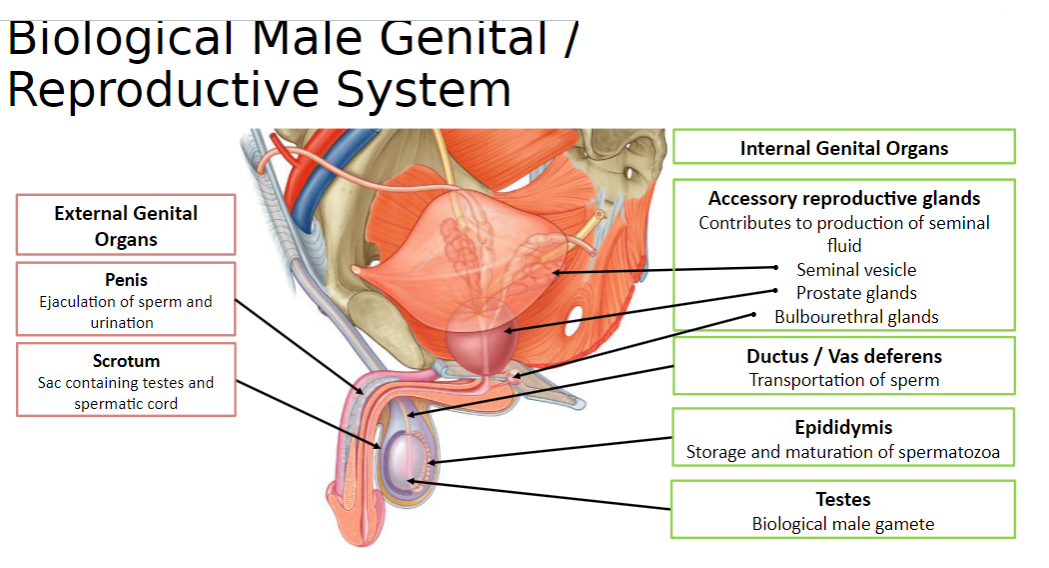
-
What is the structure of the scrotum?
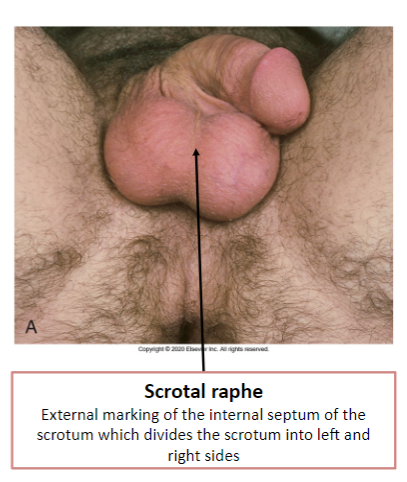
The scrotum is a cutaneous sac consisting of skin and fascia.
-
What does the scrotum contain?
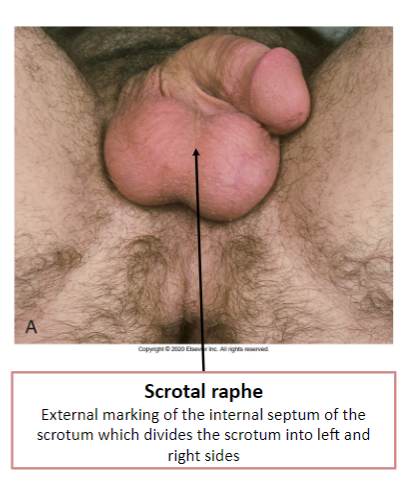
The scrotum contains the left and right testes and the spermatic cord, separated by a septum.
-
Why are the gonads externalized from the abdominopelvic cavity?
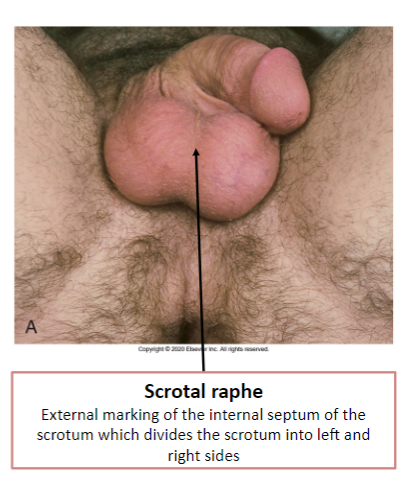
The gonads are externalized to ensure a cooler environment and allow for temperature regulation.
-
What is the scrotal raphe?
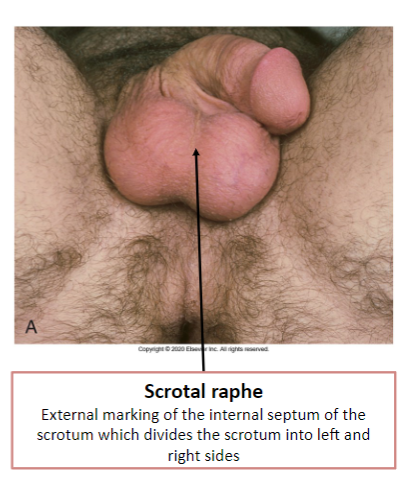
The scrotal raphe is the external marking of the internal septum of the scrotum, which divides the scrotum into left and right sides.
-
What are the testes?
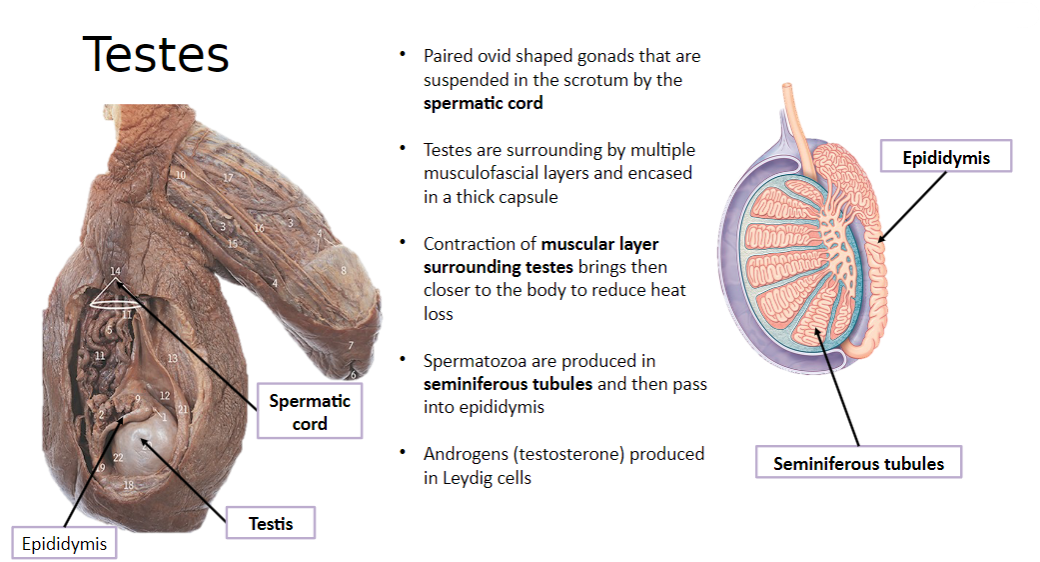
The testes are paired ovoid-shaped gonads that are suspended in the scrotum by the spermatic cord.
-
What surrounds the testes?
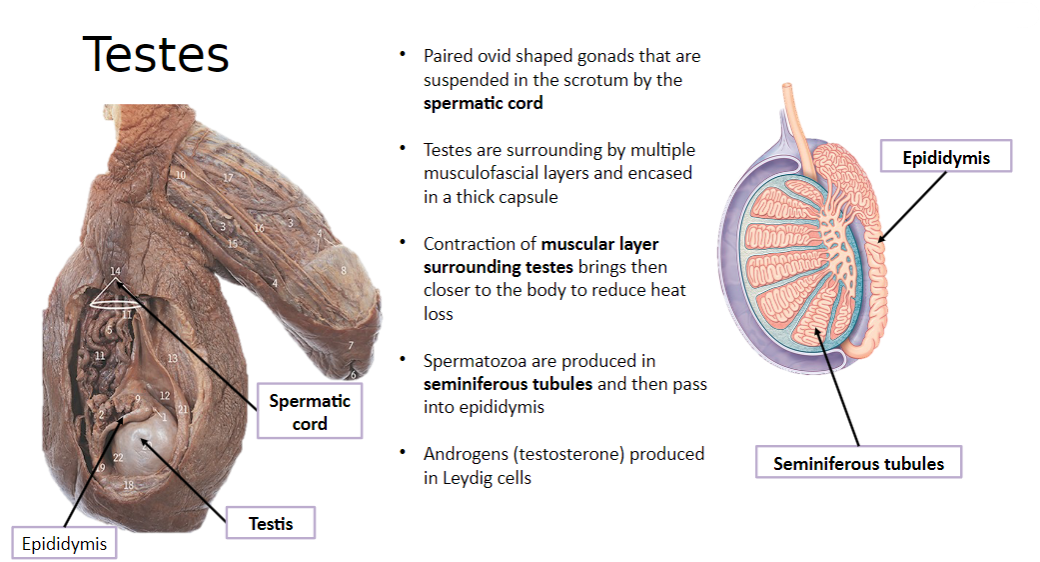
The testes are surrounded by multiple musculofascial layers and are encased in a thick capsule.
-
What is the function of the muscular layer surrounding the testes?
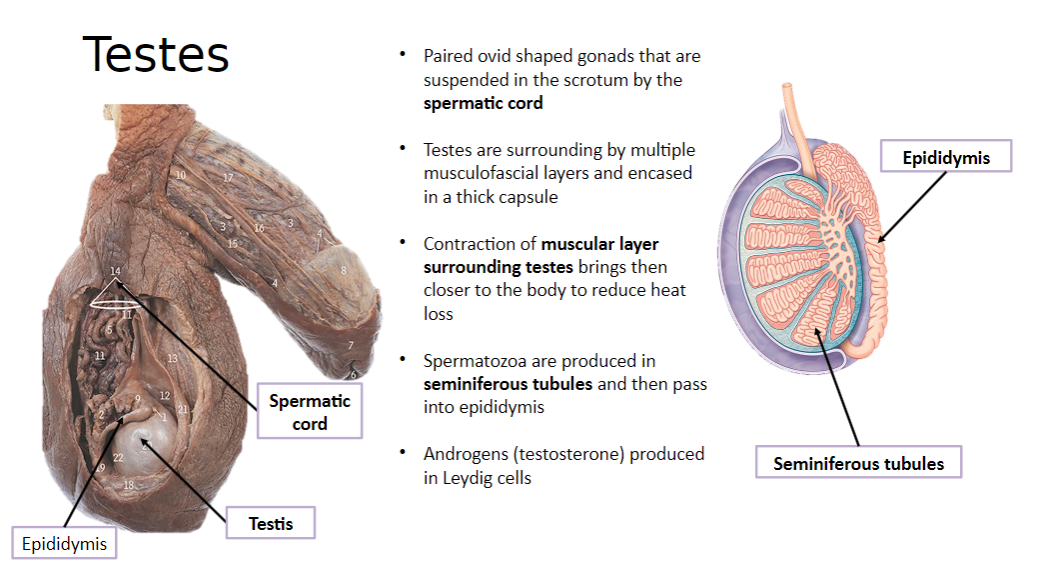
The contraction of the muscular layer surrounding the testes brings them closer to the body to reduce heat loss.
-
Where are spermatozoa produced and where do they go afterwards?
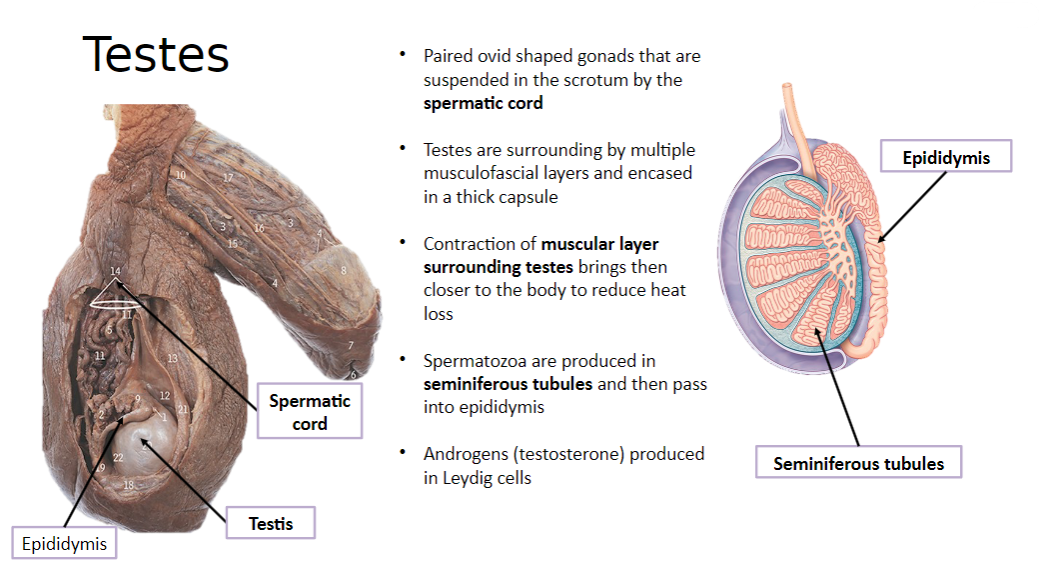
Spermatozoa are produced in the seminiferous tubules and then pass into the epididymis.
-
What do the Leydig cells in the testes produce?
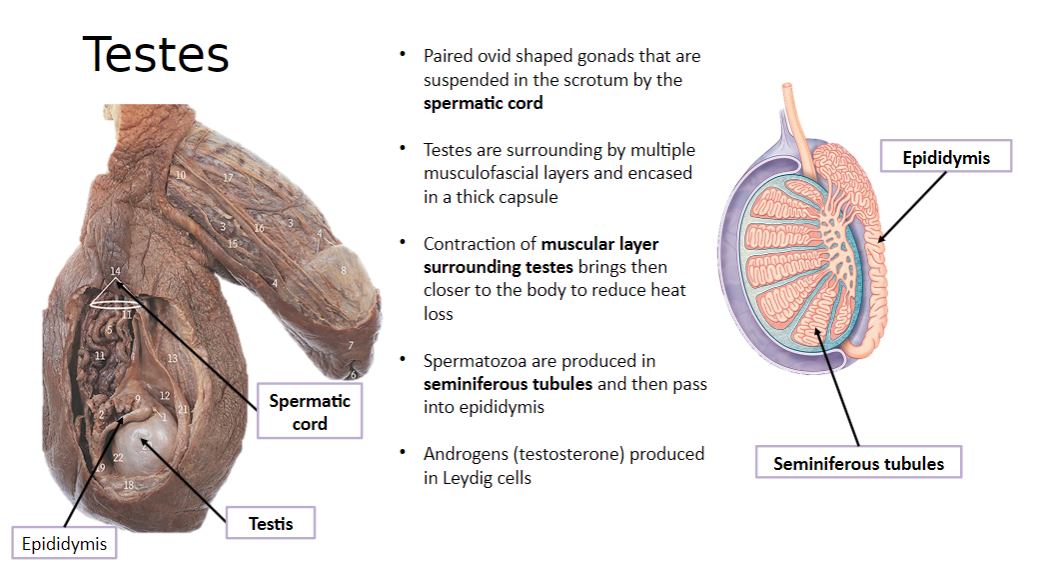
The Leydig cells in the testes produce androgens, such as testosterone.
-
What is the shape and structure of the epididymis?
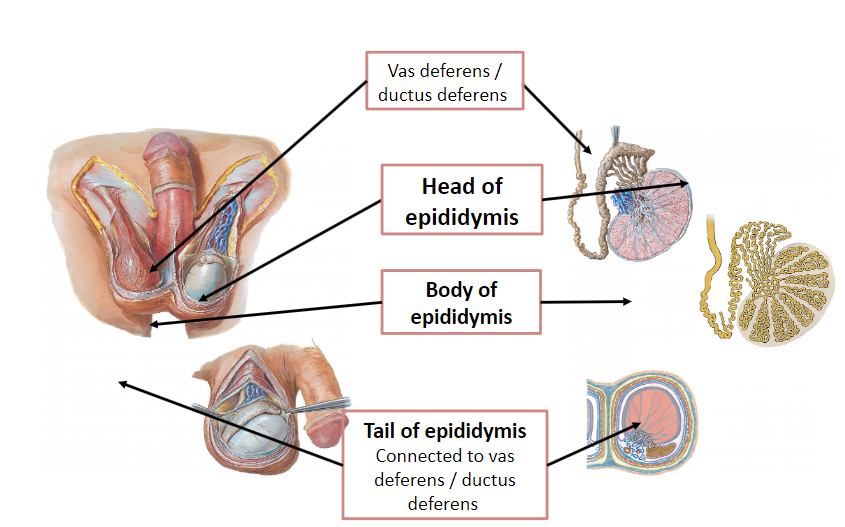
The epididymis is an elongated, comma-shaped structure formed of a long-coiled tube.
-
What does the epididymis receive from the testes?
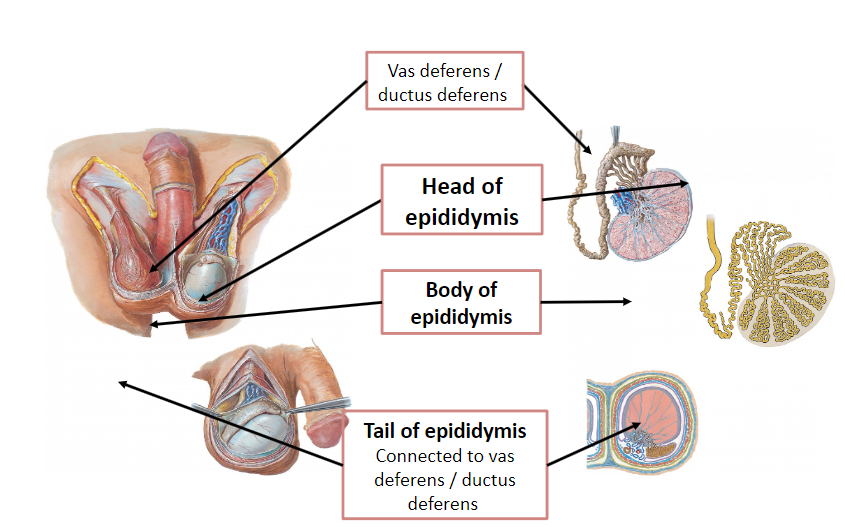
The epididymis receives spermatozoa from the testes.
-
What are the functions of the epididymis?
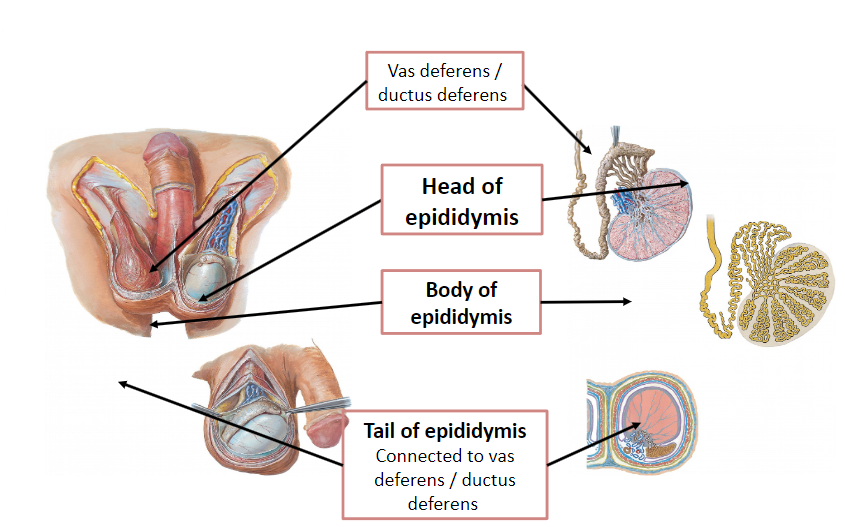
The epididymis functions to store and mature spermatozoa.
-
What does the vas deferens (ductus deferens) receive from the tail of the epididymis?
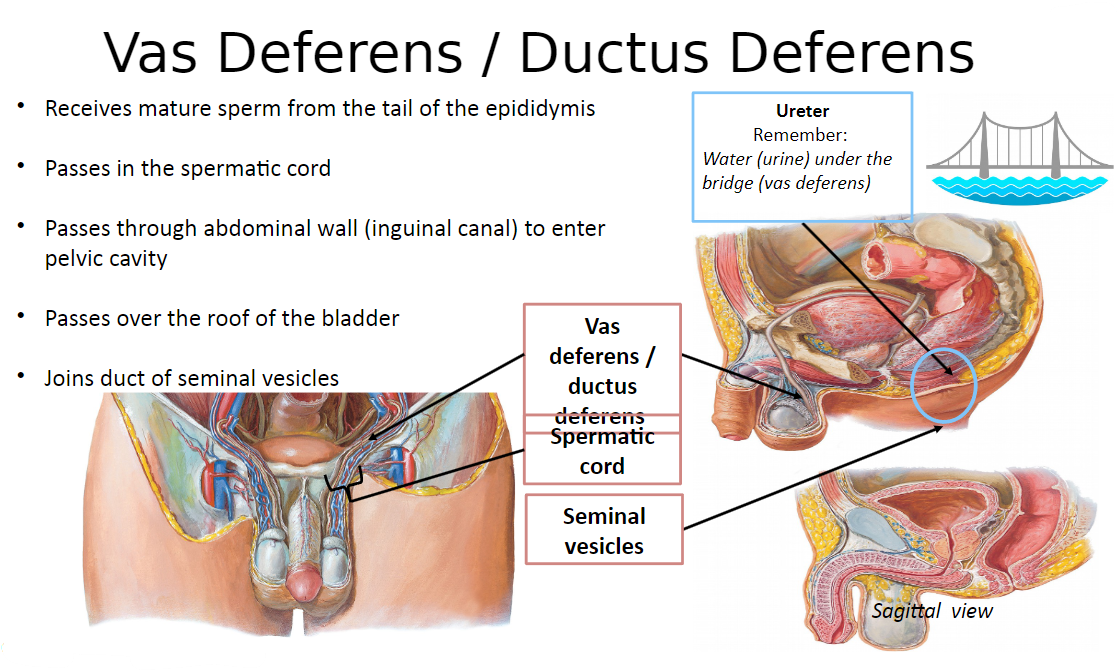
The vas deferens receives mature sperm from the tail of the epididymis.
-
Through what structure does the vas deferens pass?
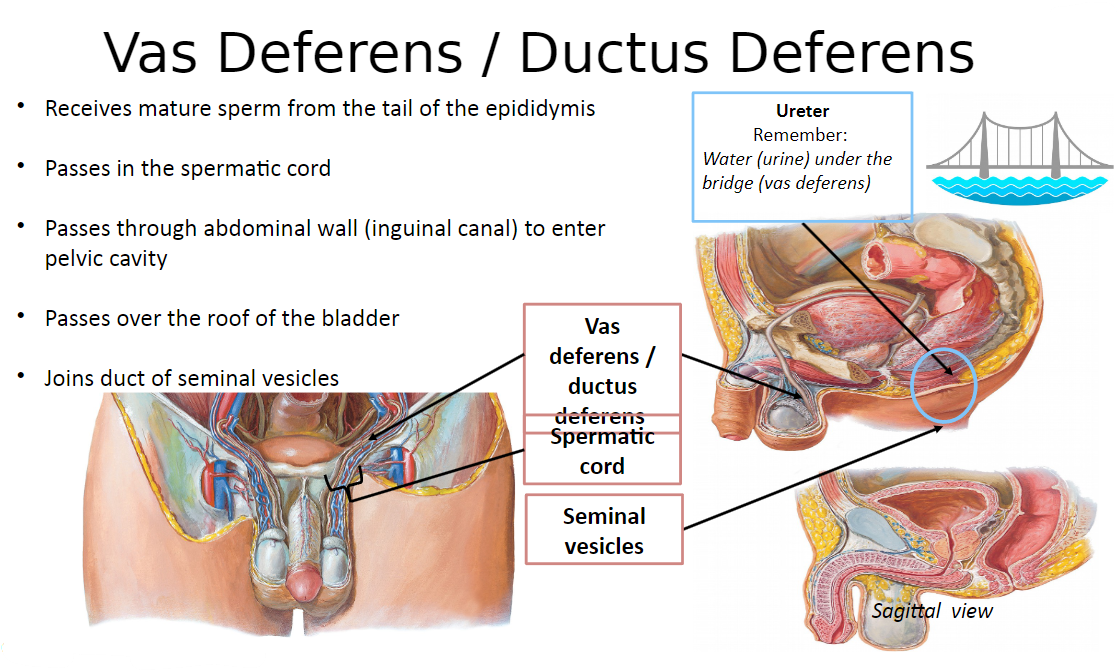
The vas deferens passes in the spermatic cord.
-
Through which canal does the vas deferens pass to enter the pelvic cavity?
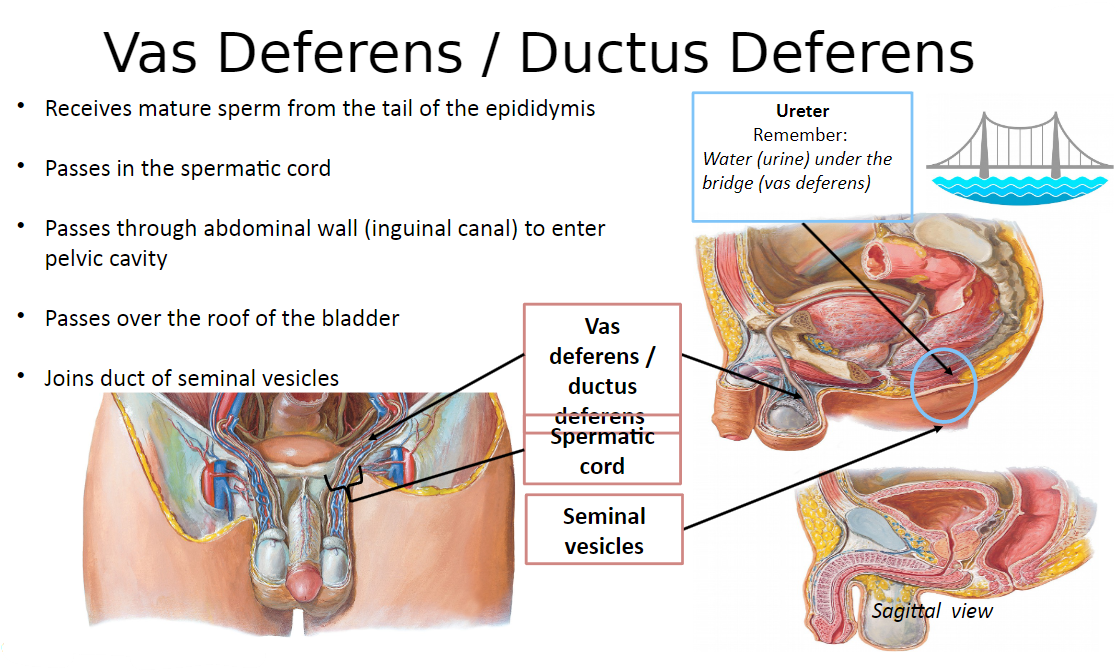
The vas deferens passes through the inguinal canal to enter the pelvic cavity.
-
Over which organ does the vas deferens pass?
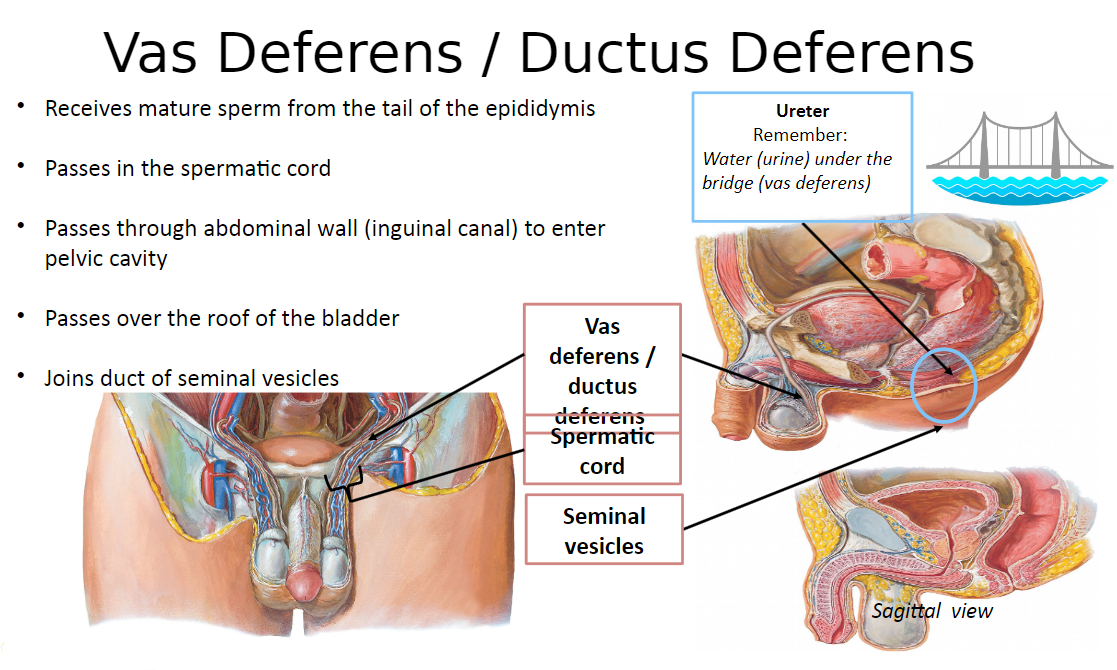
The vas deferens passes over the roof of the bladder.
-
With which duct does the vas deferens join?
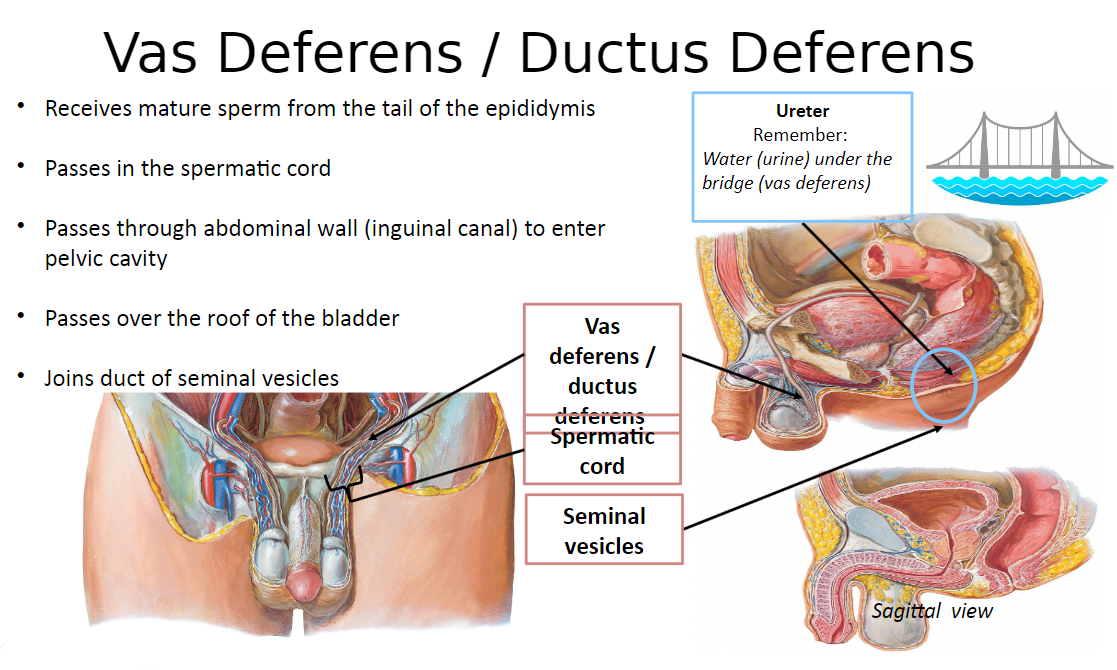
The vas deferens joins the duct of the seminal vesicles.
-
How is the ejaculatory duct formed?
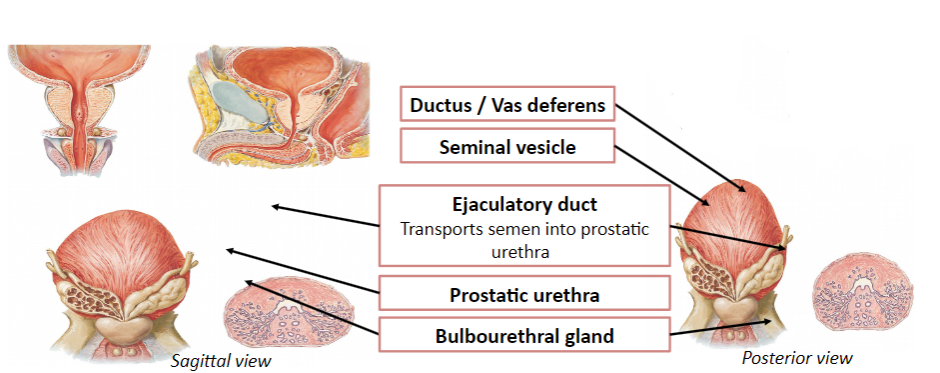
The ejaculatory duct is formed when the duct of the seminal vesicle joins the ductus (vas) deferens.
-
What is the function of the ejaculatory duct?
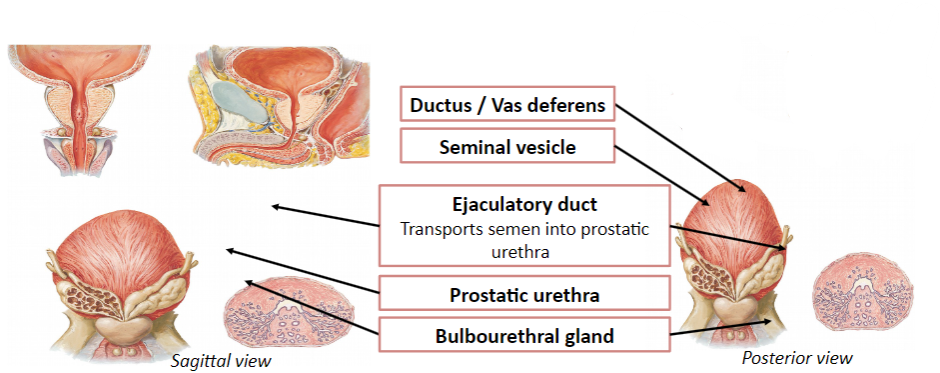
The ejaculatory duct transports semen into the prostatic urethra.
-
Picture demonstrating accessory reproductive glands:
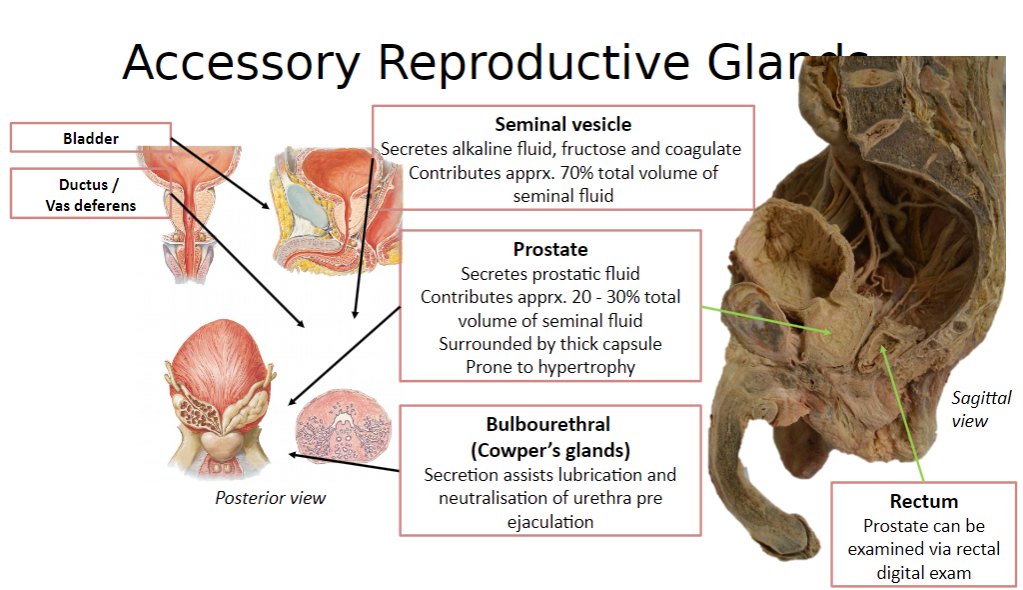
-
What are the functions of the penis?
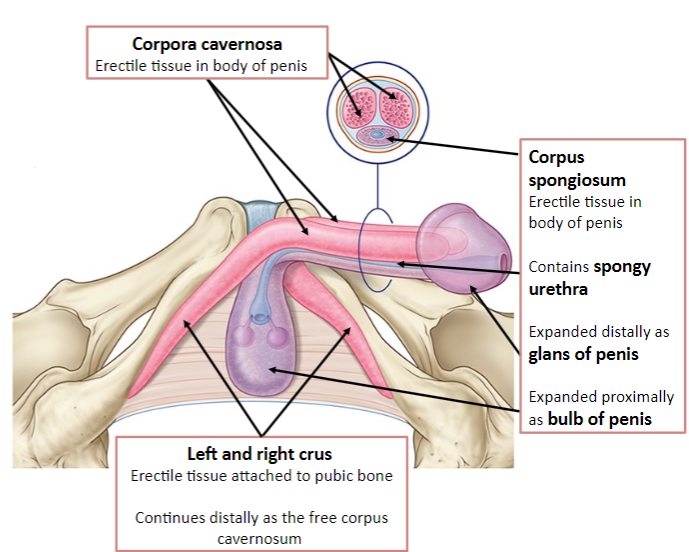
The penis serves as an outlet for semen and urine.
-
How many cylindrical bodies of erectile tissue does the penis consist of?
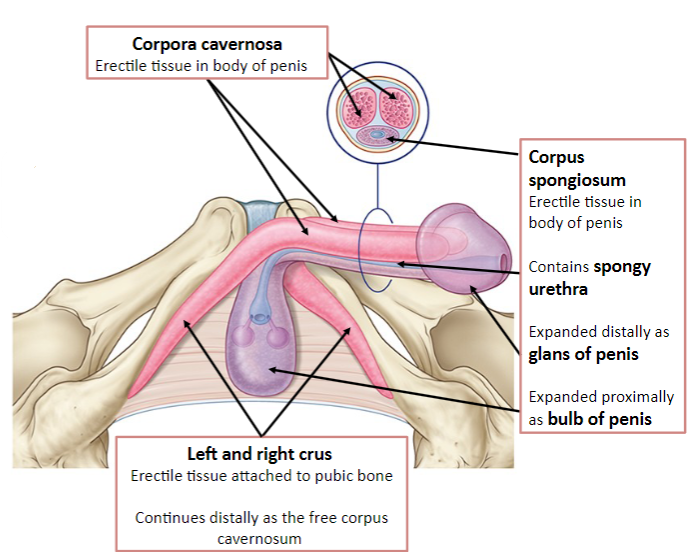
The penis consists of three cylindrical bodies of erectile tissue.
-
What are the names of the two paired cylindrical bodies of erectile tissue in the penis?
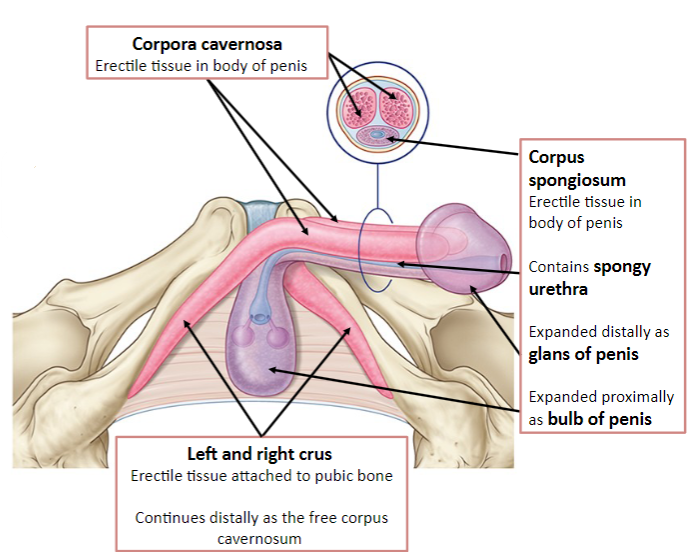
The two paired cylindrical bodies of erectile tissue are called corpora cavernosa.
-
From where do the corpora cavernosa arise?
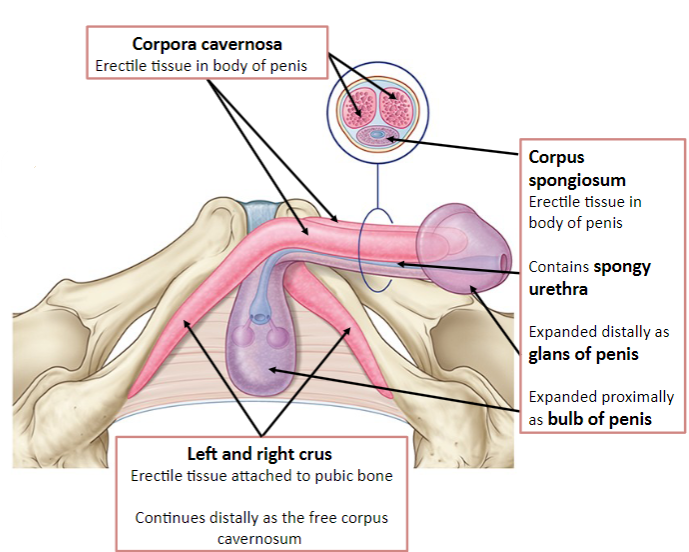
The corpora cavernosa arise from the left and right crus (crura, plural).
-
What is the name of the single cylindrical body of erectile tissue in the penis?
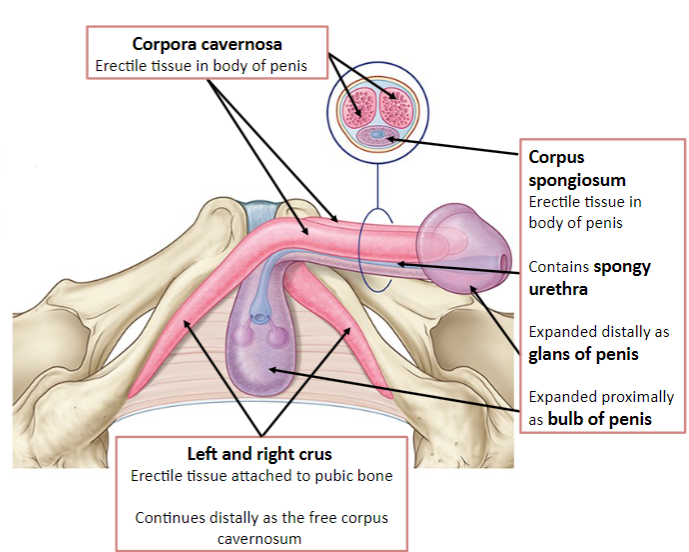
The single cylindrical body of erectile tissue is called the corpus spongiosum.
-
What does the corpus spongiosum contain?
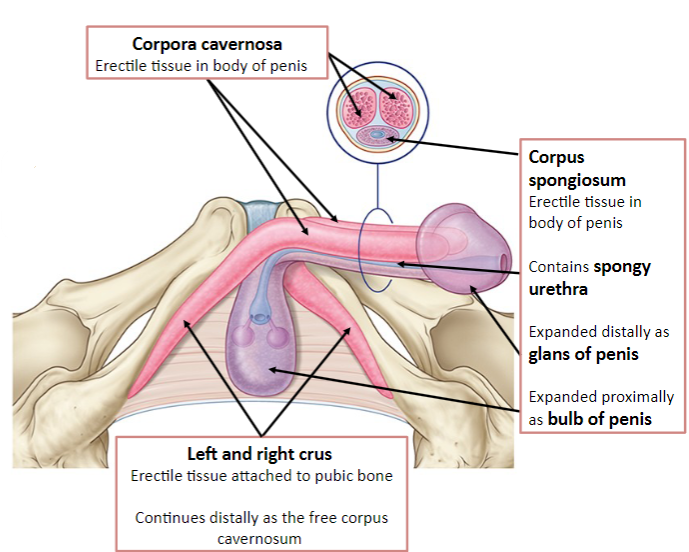
The corpus spongiosum contains the spongy urethra.
-
How does the corpus spongiosum expand distally and proximally?
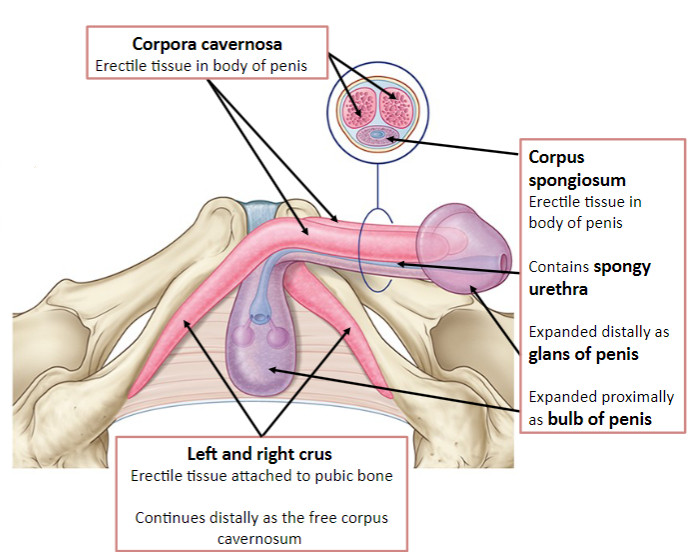
The corpus spongiosum expands distally as the glans and proximally as the bulb.
-
Another picture demonstrating the parts of the penis:
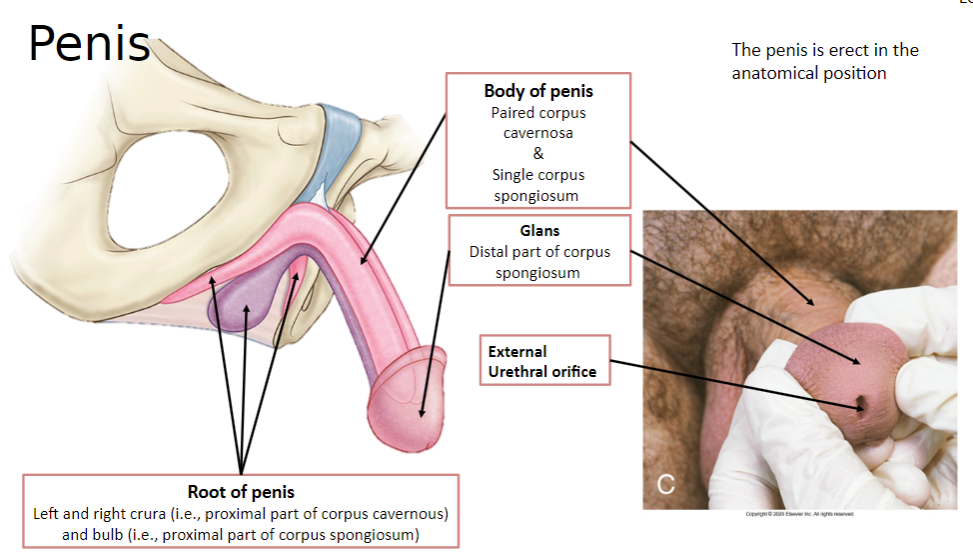
-
How is sex determined biologically?
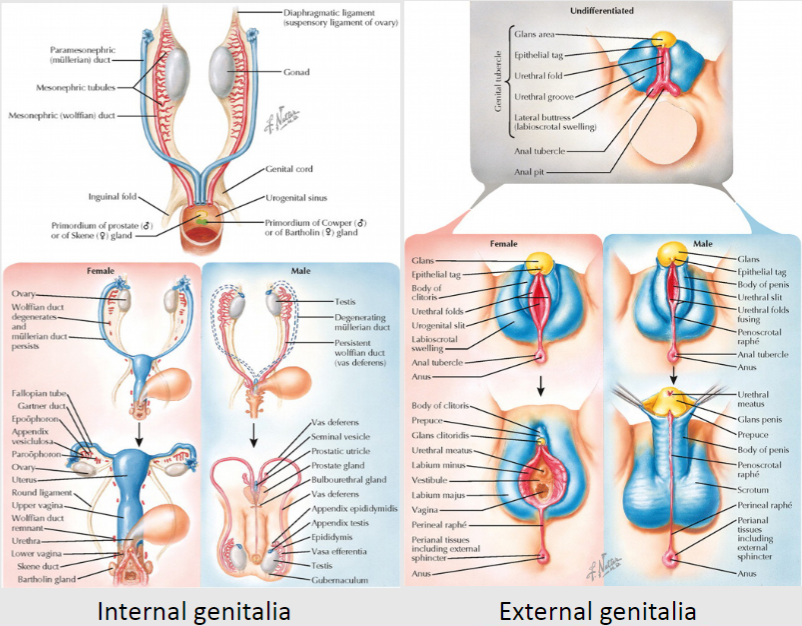
Sex is determined biologically by chromosomes, genes, and hormones.
-
What are the chromosome combinations for female and male?
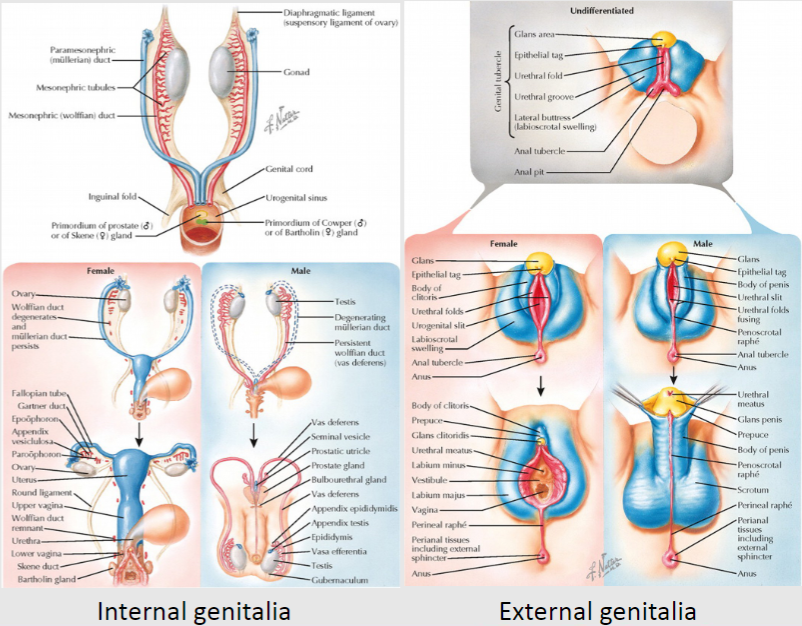
XX for female and XY for male.
-
Which gene is important for the determination of the Y chromosome?
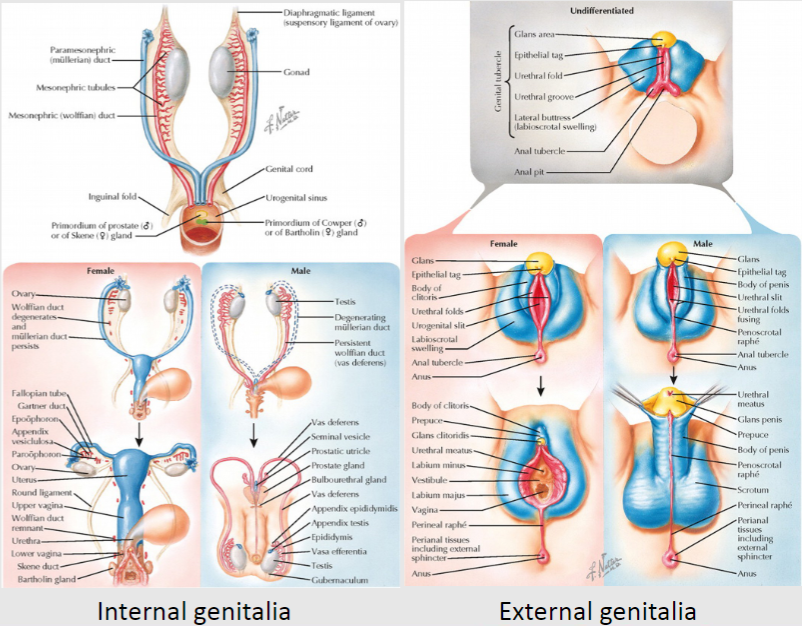
The SRY (Sex-determining Region Y) gene is important for the determination of the Y chromosome.
-
What are the fetal developmental structures involved in male reproductive system development?
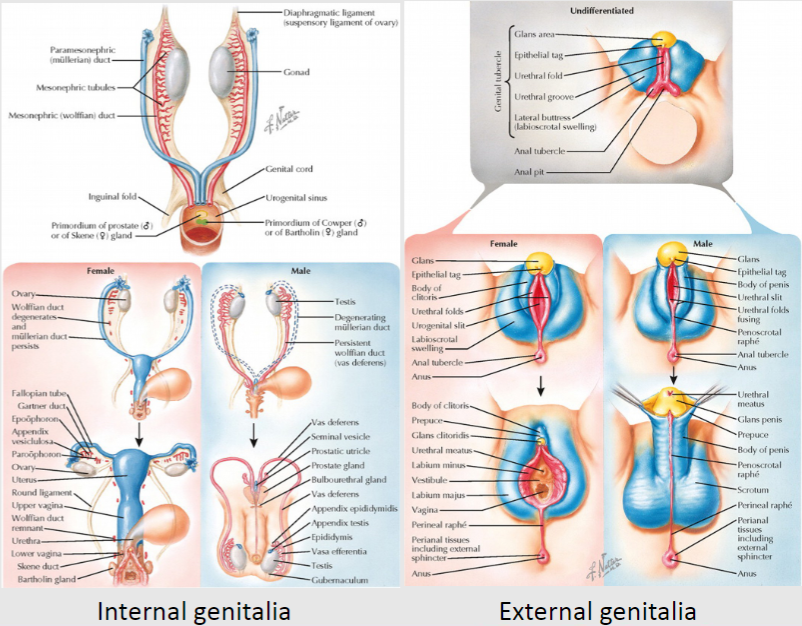
The mesonephric (Wolffian) ducts develop into the epididymis, vas deferens, ejaculatory duct, and seminal vesicle.
-
What are the fetal developmental structures involved in female reproductive system development?
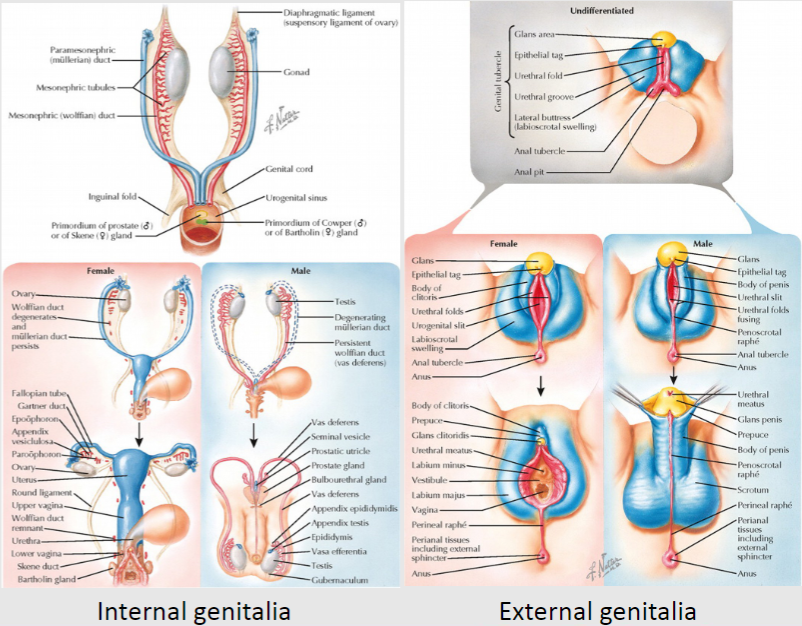
The paramesonephric (Mullerian) ducts develop into the uterine tube, uterus, cervix, and upper vagina.
-
What is another term for intersex conditions?
Intersex conditions are also known as disorders of sexual development.
-
What are some former terms for intersex conditions?
Formerly, intersex conditions were known as true or pseudohermaphroditism.
-
What are some characteristics of intersex conditions?
Characteristics of intersex conditions include chromosomal abnormalities, ambiguous genitalia, phenotypic sex anomalies, and true intersex states.
-
Biological sex will not always determine what.....?
Gender
-
Picture summary of this lecture:
